What follows below is a massive 21,000+ words on the subject of online businesses, covering the landscape, tools, strategies, tactics, and authoritative resources for further reading. Likely the equivalent of two semesters of learning material here. Maybe more, way more… So make sure to share if you like it.
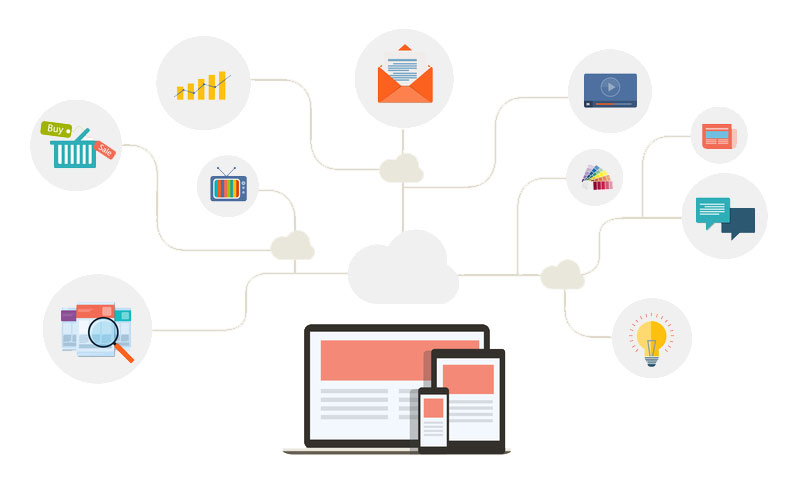
I’m fascinated by online businesses. Cannot think of any other sentence to start this guide with. It’s been three years now since I first started analyzing examples of people doing it right, and three years since me and my friend became obsessed with every aspect of it.
Scrolling through what seems to be the biggest chunk of information I would come up against in my adult life, all of my formally obtained knowledge in other verticals instantly dwarfs in significance. Though formerly studying music, and later on language and literature, I think of myself as a student of online business.
Conversion optimization, user experience, content creation, search marketing, design… the whole nine yards, really. You name it- there is a chance that me and my partner have spent weeks on top of weeks reading every scroll of information available at the time, discussing to the point of what seems to be a stream of endless conversations.
We also did our fair share of practical work as well, though having in consideration what we learned, I can easily go ahead and say that our projects fall behind our knowledge by a huge margin. Irrespective of that, we did manage to make some decent revenue, and having in mind that I hope to rely on my projects while thinking about starting a family, there is no room for complaining.
What I’ve come to realize after three years of doing this though, is that things don’t necessarily have to be so hard or time consuming. Much can be achieved with less, and despite what circling beliefs in the industry say you don’t need a degree in rocket science.
A massive time frame is not a thing that you need either.
And before we continue with this amazing topic that managed to hold together my attention for each day of the last three years, let me first explain the reason behind this guide, the title, and what to expect from it.
The reason behind this guide
The reason, quite frankly, is because why not; Why not nave a complete back-to-back resource on online businesses, and one that dares to delve deeper than the rest.
The title, though I figured might be the most appropriate, can be viewed in other ways as well. This is, truly, a beginner’s guide. Mostly in the sense of how it lacks detail when covering the topics discussed, and moreover due to the broad number of topics it includes in it.
If you read this guide, you will be able to analyze all businesses online and, depending on your ambition, create one for yourself. Here is the trick though- if you go through the suggested reading as well, and complete all the exercises included, you might end up acquiring knowledge that is the equivalent of studying a subject for a semester or two. Maybe more, way more, it is hard to quantify it.
I never had an outlet of my own that is appropriate enough for sharing such a topic. This blog was hardly in any way associated with internet marketing, and its audience couldn’t worry less about it. However, introducing our entrepreneurship category a while back, it is time to cover this topic as well. Now, when there is someone to listen, I feel the need to put this guide together.
I will try to familiarize you with every aspect of online businesses you need to know, and where appropriate, point out to sources that exhaust the topic much further.
Despite trying to be more concise and make you forget this rant of an introduction, the guide is still the length of a short book, so you might want to bookmark it for later.
Why online business?
If I need to spell it out for you, so be it… An online project, unlike those in the offline world usually takes less time to put together; far less, in fact.

This is not a general rule of thumb, but put an online business against a physical one, and nine out of ten you will see a huge gap between them. Set up investment, time, ability to scale, opportunities to reach people and hence sell… All favor the online variety.
However, albeit these realities, an online business is just like any other else for that matter. The more you invest in it, the more you get out of it; the better the idea, the bigger the chance for success. The same startup mindset that goes with founding a company with an office, applies when you are at home in your PJ’s as well.
Work is work, and there are no shortcuts around it.
Working from home might be the biggest perk I’ve felt thus far, and it is surprising how many of my peers have to get up early and commute to work, being formal and such, while still earning way less; me and my partner, in the three years we work together, have never shared an office. It is all about habit and perspective – I cannot see how to put it otherwise.
Success, defined in many terms (money, time, a more leisure and exciting approach to work) is easier to achieve in an online environment than any other field of work that I know of. It takes far less of a legwork as well.
And while it is granted that online businesses can generate more passive streams of revenue (I once went without actually working for two months and still kept my paycheck close to what I usually make), you will still have to work at one point or another.
So far, I can argue only on the point of flexibility and comfort. Everything else is more or less the same.
In addition, the merge of online and physical businesses is so spontaneous and intuitive these days that just writing about them in distinction makes me feel like I’m lagging behind.
Note from author
Before you go ahead and immerse yourself into what follows, have in mind that this guide is free and it always will be. That being said, I urge you to bookmark this page, for it is hard to go over the entirety of it in one sitting.
This guide has changed the careers of many people. Find out why.
Basic requirements
Analyzing so many different and diverse projects, it is hard figuring out what are the basic requirements that most of them share. In the online world, it really seems as though everything is relative. And while many things are optional, here are some basics:
Setting up a site

Buying the domain, hosting, and taking care about the design of the site. Rudimentary as it may sound for some, this step can be time consuming if honed to perfection. Besides, many people are completely uneducated about the technical aspect of all this, so you are really left with two options here:
- a) learn these technicalities and put together something that will improve over time
- b) pay someone to do it for you.
Regardless of which path you chose to follow, you will need some basic knowledge about what is, for example, a content management system, how to use it, and maybe even learn some code.
Deciding over a content management system, most webmasters nowadays go with WordPress. Easily managed, offering a very broad range of fully customizable themes, it is amazing how this works for both beginners and professionals alike. In addition, here is a list of free WordPress themes to choose from.
You can only imagine what the paid versions buy you in terms of design and functionality. Best thing of all? It will cost you your lunch money for a day or two. And I know that some online businesses might require a small fortune to build, but this argument falls short when put against what you can do on the other end of the spectrum- build one for free, and still generate income. Tell me about an offline business variety that offers the same…
Putting something there

We will cover both content and monetization in far more depth later on, but for now let me just go ahead and explain a basic concept.
The site is your shop. On its own, it is an empty room. In order to make money when people come and visit, you will need to place something there. Forgetting that I’m talking to adult people and not some five year olds, it is still important to note that.
The thing that you are about to “sell” on your site doesn’t need to be a “thing” at all. As there are lots and lots of companies selling nothing but services you can hardly understand, so you can skip a physical and tangible product as well.
Monetization can be done in myriad of ways, but having one or more of these, is a must.
- You will need content. Content that either informs and educates, or maybe even entertains. Just like magazines sell nothing but words, so you can follow a same path. And your content doesn’t necessarily need to be limited to words either. You can place pictures, film a video, record a podcast… This content can be sold via membership fees, or it can attract a targeted audience to which you can later on market stuff and thus earn. Just like with anything else you offer to the world, the content you place on your site should aim to be of higher quality. You will have to practice your writing voice, or a certain style of filming, or recording, or whatever else your idea of content is.
- A separate or parallel suggestion with the one above would be to sell a product. It can be a physical product, or a digital one – an e-book, video course, an app. Product creation is usually hard, and requires a lot of skills and knowledge. Depending on the size of the project it can rank somewhere between fairly easy to put together and something that takes years of preparation. There is an option to even sell someone else’s product as well.
- You can offer services such as consulting, or sell your skills as a freelancer. The opportunities go as far as your imagination can stretch.
- A lot more complex, though manageable if you have the means, is selling software. There are so many different needs that software can reach and fulfill nowadays, it is certainly shame to exclude it as an option from the list.
- Finally, as with any business you can think of, there is still the chance to sell it at one point or another.
Some ideas, in order to be materialized on the net, might require some degree of web development. For the purpose of keeping close to the basics, I will exclude this, and say only few words on the subject- unless you have someone on your team who works web development, it can be a very time and money consuming process. As there are ideas that cannot be materialized by using WordPress only, outsourcing this process is the only viable solution.
Note from author
A second inside note usually bores people. Not me though, I have a pic of two turtles.

They go over things slow, as should you by now. What follows can seem boring at first, but understand that though these are basic stuff, many are viewed from first principle perspective – meaning – they provide insight beyond a simple definition, and can change the way you look at things.
Basic terminology
When it comes to online businesses, even the most basic of concepts are hard to explain without throwing some internet marketing terminology in there. I thought very hard about this, and figured that there is no single way to chronologically place all the terms and phrases. Yet alone order them by importance.
The following list will maybe take you through some slightly more advanced concepts, and then back again to some broader ones as well. Bear with me.
Landing pages

As I’ve said – under no order whatsoever- let us discuss what a landing page is, and what you need to know about it.
This is the place where you will send visitors who come to the site. In fact, every page on your site can well be a landing page. People usually refer to pages that sell something in a more obvious way- but even a single review of a product can be treated like a landing page.
A landing page incorporates various aspects of User experience and design, along with some carefully honed copywriting skills. It doesn’t have to be very obvious and certainly not limited to what old school chaps are referring to when mentioning landing pages.
Traffic

As with any business, traffic is what moves the numbers up in sales. On the internet, traffic can circulate from everywhere. Referral sites, social channels, search, forums, YouTube… the list goes on and on.
The more traffic you bring to your site, the bigger the profit; though this doesn’t necessarily have to be true. For example, you can take a million people to see a website that is about something totally out of the sphere of their interest, and this will serve to achieve nothing. On the other hand, taking a single person to something very relevant to his interests might result in hundreds of dollars of profit. Finding the balance can take practice, reading a lot, and some common sense.
What you need is targeted traffic, and though easier to come by on the net than anywhere else, you will still need to learn a thing or two about attracting it.
SEO (search engine optimization)

An industry by itself, it is by far the most effective way of bringing massive numbers of traffic to your site. The stats keep changing at a rapid clip, but know this- Google registers billions of searches per day. Some phrases bring millions of searches per month, and others a handful, but majority of these people click on the first couple of results on the search page.
Getting in there might mean earning millions, falling down a page, or even few places- losing all your revenue.
In reality things are not so stark though. You can rank well for some phrases and not so for others, and still manage to bring decent traffic. And while traffic is better when converted into sales instantly, you can manage a way around less targeted traffic and still find a way to monetize.
Lifestyle Updated brings somewhere around 90,000 people per month, and we track around 500 phrases for which we either rank, or hope to rank.
And while getting traffic to your site or landing page is important, what is even more important is getting the right traffic. SEO, as you might’ve guessed, brings traffic that is way more targeted, hence way more likely to result in conversions (sales, subscriptions, social shares…pretty much all the good stuff).
Let us be transparent now- over 80 percent of the traffic that Lifestyle Updated has, comes from SEO. Most of our other projects share a similar Pie chart as well. And if you must take away only one thing from this article, let it be this- SEO, though actually very hard to learn in its entirety (not sure there is such a thing anyway), is pretty easy when striped down to just the things you will need in order to duplicate our numbers; or even attract more, way more.
The on-page factors, though having to learn them, usually go hand in hand with quality content and well-done user experience. Semantic relevancy, organically placed keywords where they make sense, well-structured page overall. Here is an article from Moz that delves deeper into this topic.
What usually ignites a spark between SEO aficionados nowadays though is the controversy surrounding off-page factors. Namely, when ranking a site for a certain query, Google evaluates hundreds of factors. Not only that many of them are off-page (like other sites pointing to yours), but it seems as though they contribute the most to whether something will rank high or not. Having said this, SEO’s mostly argue about what kind of strategies are to be applied when off-page factors are concerned.
So far, links coming from other sites are probably the number one factor when ranking high. And while some people are advocating content marketing and what SEO’s call white hat strategies, others go down a more risky path, trying to influence their rankings in a more obvious way. Glen from ViperChill writes extensively about such experiments (here, here and here).
I myself have learned not to play risky when going out and acquiring links, and subscribed to the policy of earning them instead of building them. Requiring more quality work, this never really caught up. I try to keep things clean though. Link building has become a very demanding process over the last decade, and Jon Cooper is by far authority on the subject. Here is why.
For total beginners in SEO, here is the Beginners guide to SEO from Moz. Rand also makes his Whiteboard Friday videos in order to familiarize you with a more holistic approach to SEO.
Mailing list
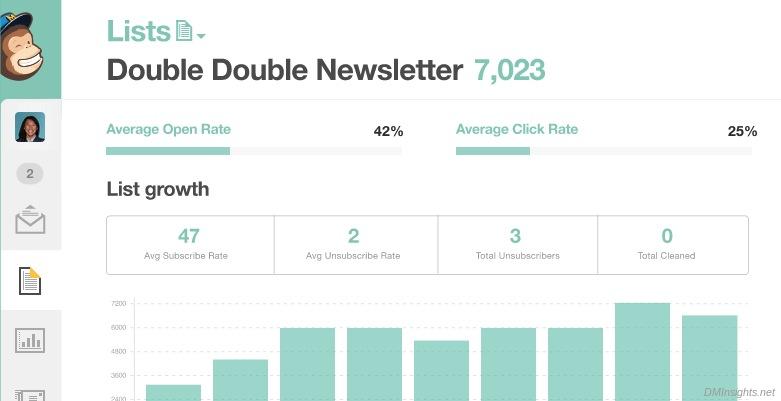
Mail has been around from the beginning of the internet, and regardless of what new tool is currently trending, it intends to stay. And here is the thing- Google, and even Facebook, constantly change their algorithms and the content they show to people. In such a volatile field, it is nice having a traffic source you can always rely upon- Enters the mail list.
Having a mail list is great for couple of reasons. Once bringing a subscriber in, you can start to slowly build connection with that person by sending emails that further boost your credibility or create trust bonds.
You can do this by sharing your best content or, as some people do, create automated mail sequences that are send once a subscriber comes on board. Giving something valuable in your mails, be that a pdf resource about something that is relevant to their interests, a free book, or whatever, will make it more likely for every future sales pitch to be welcomed instead of ignored.
But how does one acquire mail addresses, you ask?
Squeeze pages/lead magnets
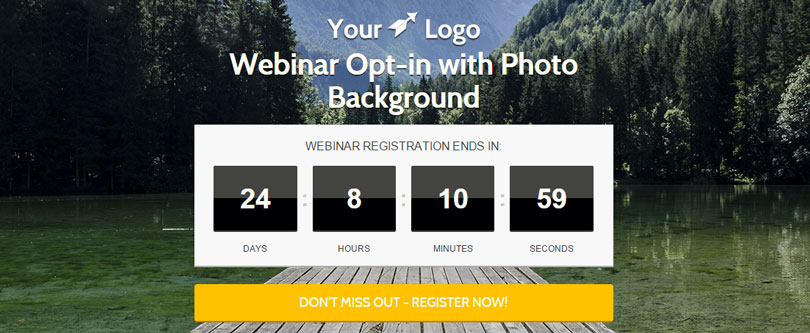
Before someone gives you his mail address, two things usually occur:
- You are publishing some great content, and this person loves to consume everything that you are making.
- You are offering something valuable for free, and ask for a mail address in return.
While the first scenario would be ideal, it is rare at best- Hence the need for a squeeze page. This is where you send people in order to trade some valuable resource in exchange for their mail address.
Clay Collins from Lead Pages along with John Chow, made a great webinar on the whole process of acquiring mails through squeeze pages, sending an automated mail sequence, and then selling some product of your own. It is very long, but packed full with vary valuable info and strategies, and some detailed advice. Check it out here. It is by far the most complex, yet simple strategy for acquiring massive numbers of emails.
Opt-in box
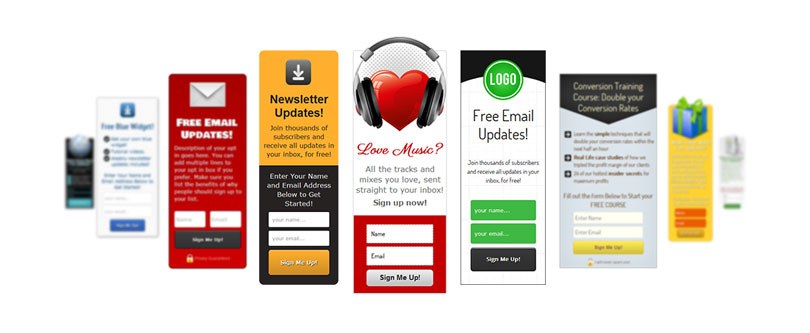
The need for a squeeze page is not always there though. And while Collins might argue otherwise and point out to numbers that show a more promising set of scenarios, some people are doing very well even without having a squeeze page.
The opt-in box does, more or less the same job. People usually place it on the bottom of their articles, or use the sidebar instead. Some even make the opt-in box a pop-up window and program it to appear when the reader reaches a certain point in the article while scrolling.
There are many sorts of opt-in forms, and some even go as far as making plugins in order to make them fully customizable. Glen from ViperChill, again, does a great job with this by offering his own plugin called Opt-in Skin (not an affiliate link).
Split testing or A/B testing
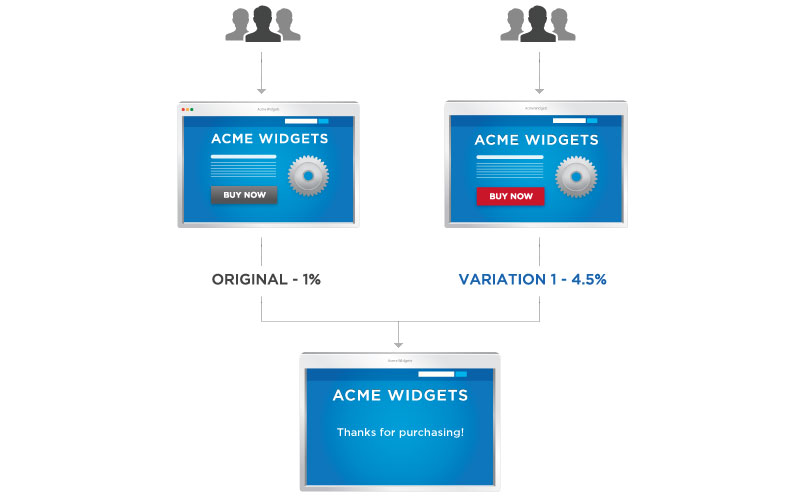
There are services out there that let you bring traffic towards two slightly different versions of one piece of content. Imagine that you are making a sales page about a product but hesitate over whether to put testimonials or not. Or further even – what color the text in the box should be…
Split testing allows you to generate these differences and then send traffic to both, figuring out which one is better.
Basic tools
Have these tools in mind while scrolling through the rest of this guide. The ways in which you can use them are numerous at best, and greatest thing of all is that you can play with them for free.
Google Trends
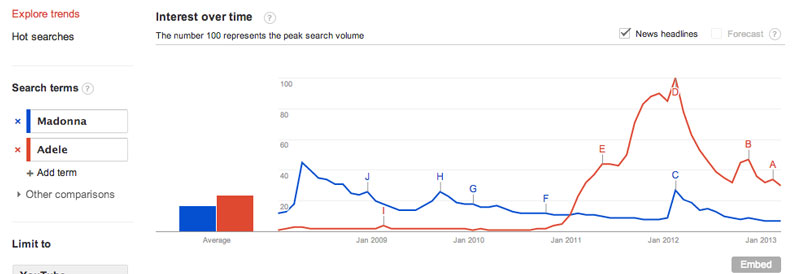
This is one of the best tools not only for online businesses, but many other verticals as well- All those queries that Google has received over the last decade? Well, guess what, you can have that insight within seconds. Just type a query, or two of them, and you will see how popular throughout the years they’ve been. You will also see information like popularity in different countries that might, for example, guide you when trying to choose your market.
Google Keyword tool
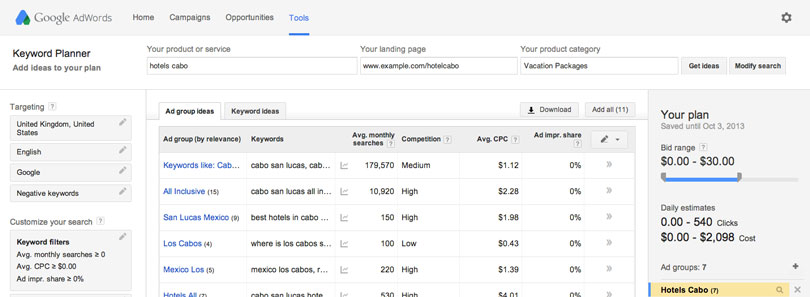
This one is golden. I can know with almost certainty how much a certain query has been searched for, and thus decide whether or not it is worth to pursue the search traffic with SEO work. This is how we earned from our reviews – found spikes in search traffic, used our knowledge to create resources around these topics, and ranked them high. Oh, and it is also for free.
Google Analytics

Free tracking of your sites, and aspects like traffic sources, time spend on site, action completed, and visitor’s flow… You can track almost everything with this free tool.
Note from author
If you were Uma Thurman in Kill Bill, everything so far would have been climbing stairs with buckets of water. Nah… basics. Though not necessarily fun at all.
Now however, is time to learn some kicks.
A process to walk you through
Getting familiar with some of the terms used by online marketers, people assume they’ve hacked the way in which business is done online. And this is as further from the truth as it can be.
Another thing that makes me angry though is the bad rep these folks attach to online marketers. Many assume that simply knowing the tactics and strategies we use for monetizing, gives them the right to mark our work as fraud, scam etc. We know how television works, and how TV shows are done for the sole purpose of revenue, yet nobody ever protests- The whole of advertising too; products, services, entertainment… all have their strategic background. Knowing how something generates income doesn’t necessarily have to mean lowering its quality by default, or placing suspicion on whether or not it is well-intended.
The process I’m about to describe (one of the many approaches to online businesses) might seem a tad mechanical and robotic. It doesn’t, however, make any of the core values of the business less important. This is simply marketing done strategically, so bear with me.
Bring traffic to the site
Agreeing that targeted traffic is important, there are still lots of angles to explain about how to bring it to your site. Not delving too deep, I will go ahead and discriminate between paid marketing and inbound marketing.
Paid marketing, as common sense dictates, are your sponsored articles on Facebook, your sidebar ads, your Google paid listings… There are much more places online where you can pay in order to boost the visibility of your brand. And while it is very easy to give advice in the lines of- just place a Facebook ad- the reality of it is that this is a science on its own.

Nail Patel from QuickSprout has made an incredible job with his Beginners guide to online marketing, and Chapter 7 discusses this topic in detail. If you are planning to expand your knowledge in internet marketing and become able to perceive a bigger picture, I strongly advise you to read the whole guide.
Here is another guide from Neil discussing how to build your audience. Pay more attention to chapter six which is about paid social media.
As Wikipedia says:
Inbound marketing is promoting a company through blogs, podcasts, video, eBooks, enewsletters, whitepapers, SEO, social media marketing, and other forms of content marketing which serve to attract customers. In contrast, buying attention, cold-calling, direct paper mail, radio, TV advertisements, sales flyers, spam, telemarketing and traditional advertising are considered “outbound marketing”. Inbound marketing refers to marketing activities that bring visitors in, rather than marketers having to go out to get prospects’ attention. Inbound marketing earns the attention of customers, makes the company easy to be found and draws customers to the website by producing interesting content.
The reality here is that there are no rules of which one is better. Some are more versed using the first set of methods, while others are practicing the second one. Darren Rowse from Problogger says this:
And it totally makes sense. If you are making a site about music and popular songs, it is likely that your targeted audience will be on YouTube. Paid ads or videos – at this poins these are just technicalities. The important thing is to make your presence there and tweak things over time.
Exercise #1
Take a guess on who might be your audience and where you can find them. Ask yourself- what type of sites is your targeted audience frequently visiting, are they likely to gather on forums, or Facebook, or what are the search queries they might think of?
Understanding your audience means being more specific about their demographic group; this will, in turn, allow you to better understand random affinities (a term coined by Ian Lurie).
 “Two topics have ‘random affinity’ if they are connected only by a common audience. For example: the fact that I like cycling may mean I’m more likely to watch “Adventure Time.” There’s no subject connection between cycling and “Adventure Time” – Jake and Finn never ride a bicycle. The only connection is the fact that an unusual number of people are interested in both.”
“Two topics have ‘random affinity’ if they are connected only by a common audience. For example: the fact that I like cycling may mean I’m more likely to watch “Adventure Time.” There’s no subject connection between cycling and “Adventure Time” – Jake and Finn never ride a bicycle. The only connection is the fact that an unusual number of people are interested in both.”
You can use this same concept when trying to guess where your targeted audience might gather. LinkedIn or Twitter, Facebook or Pinterest… Do they like memes, or are they more satisfied watching close-ups from meals and food?
Reading Ian’s article is an easy way towards understanding how to make connections between topics, and thus be more able to recognize random affinities.
Exercise #2
Try to imagine what else your audience is interested it. It will guide you towards which platforms they are frequenting the most.
Pat Flynn from Smart Passive Income – a site that I seriously advise you to follow – has another motto: “Be everywhere.”
Exercise #3
Try to think about all the channels you can make a presence on in order to bring in more traffic. Ask yourself – what are your strengths, and where can you leverage them the most? You have things to say- then make a podcast; have a way with people and know how to get their attention on social media – invest some time in Facebook, twitter, pinterest…
Convert visitors
Say hello to user experience and conversion optimization. This is a science on its own, so I will try not to make a mockery of myself and this chapter by thinking that I can include everything there is to know about it in this guide.
This is where you concern over things like site architecture, design, the general flow of the visitors once they enter your site through one door or the other.
User experience is a very broad and all-encompassing field, whereas conversion optimization focuses more on the task of converting traffic.
The ultimate goal of it all is to achieve one of the following things:
(Not listed by order of importance)
- Sell them something
- Send them to buy something
- Make them subscribe to one of your mailing lists
- Make them share your work
- Make them return
- Give them something valuable (info, app, free trial, experience…) so that they return
- Familiarize them with your brand the way you like
First of all, every webmaster has his way of doing things, and while a single sale for some might mean the world, for others it is nothing but losing a potential long-term customer. While some people are satisfied with selling a third party product, others are sometimes more satisfied with converting you into a returning visitor. And there is no correct way around this either.
You will have to make sure there is a strategy in mind, and then bring visitors towards this idea of conversion.
As to expand your understanding of what this all means, here are some examples of people converting visitors in different ways using different methods.
- Some would split test the heck out of a landing page, and then bring in traffic in order to sell a product. In addition to this strategy, they might even set up a squeeze page and drive some traffic there as well. The conversion goal of the landing page would be to sell, and of the squeeze page to gather emails.
- Others go ahead and follow a more long-term and less obvious route. These are usually people that care more, love their niche, and are ready to give something back. A great example of this is BlogTyrant by Ramsay Taplin, who puts his conversion focus on making returning visitors and a very engaged audience. This means having to invest a lot more energy into creating content, but having in mind that all of his articles earn somewhere around 100 comments right after they are published, it is worth it.
His audience even has a name- Tyrant Troops, and they are a huge community and always there to spread the word. Ready to give back, they are likely to support BlogTyrant by buying recommended affiliate products whenever Ramsay mentions them here and there.
Learning everything there is about blogging, I strongly recommend visiting some of his most popular articles, and becoming one of the Tyrant Troops yourself.
Conversion optimization, though concerned with many principles and stats, has a lot to do with creativity as well. The more creative you are, the more likely it is for you to put all the pieces of the puzzle together, in a way that makes visitors engage.
Back when I was in kindergarten, this industry didn’t even exist, and I didn’t know anything about it. Now, at 24, I’m only slightly better at it. User experience, and conversion optimization too, are very broad fields that expand beyond what you can learn out of a textbook. In order to be good at it, to be creative, you will constantly have to look for examples of other people’s work.
If you want to delve deep into these topics, there is a guy on the net who makes a great job explaining principles, strategies, and tactics related to conversion optimization. By far, his site – Conversion XL is the most valuable resource on these broad topics. His articles are very neat and concise as well. In addition, since he always points out to other projects, you will be able to find many examples of work done right.
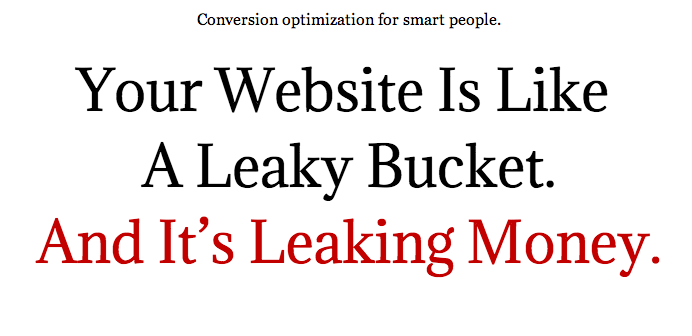
If you are only slightly interested in User experience and conversion optimization, go ahead and read this article on 17 Ways To Improve Your Blog – Case Study. I’ve been sending people to this URL ever since it was published, and it serves as an excellent introduction to such a complex field, without having to do anything else than a case study of a single site.
Before I start with exercises, another thing bears mentioning. Namely, the more you soak your hands into conversion optimization techniques and strategies, the more you realize that various tools can easily become your best friends.
And here is the difference between your average internet marketer, and someone who is quite versed in the art of conversion optimization – a single tool can turn everything around. Take Sumome for example, another ridiculously valuable package that offers a palate of very useful traffic generation, content analysis and opt-in tools bundled together.
Exercises
Being a huge fan of reverse engineering as a method of learning things, I cannot think of any other way that fits better here. Many webmasters have built successful businesses on top of years and years of trial and error, and there is no better place to understand what works and what doesn’t than trying to analyze such projects.
If you don’t want to change the angle only after shit hits the fan, or spend weeks and months of putting down one proverbial fire after another, it is wise to open a couple of new tabs and start analyzing as much as you can. Being a science that is in a constant change and flux, many things are still learned from example.
Exercise #4
Open as many sites as you can, and look at their design, content formats, and explore their presence on other platforms as well.
In order to accumulate more ideas with this exercise, try and think about your project whenever you stumble across something that has been done well. Think about how you can leverage a similar tactic, a similar approach, and take your idea through all the possible scenarios and setting that you will encounter while browsing.
I probably should have mentioned this way earlier, but knowing well enough that many beginners would simply walk away from the concept, here it is now- try and think about a single idea of a website. What would it be about, what would it sell? Now – with this in mind – go over the exercise #4, and try to polish your idea by adopting other creative solutions.
After you read this article, you might want to go over it again using the same concept.
Exercise #5
Set up your RSS reader, and start consuming content, while again searching for things like design solutions, content formats, ways of approaching ideas, voice of writing etc.
I can offer you some examples of sites to follow, and if you are interested just send me an email. (Learning how to find contact addresses from people takes practice as well- should you look it up on Twitter, should you send a private message, or use the contact form of the site…? What your subject line should look like, and will that be enough to attract attention from the site owner? Here, trial and error will teach you way more than I can. Oh, and some of the sites I already linked to have scrolls of information about this topic as well. Learn how to search for it; for anything else really- it will make a huge difference. But I digress…)
So where were we? Oh right, following other sites and other people – do yourself a favor and recognize quality from the beginning. The moment you realize that weeks have passed without that site offering something for you to learn from, it might be the time to delete it from your feed reader. Give them a chance though.
Follow sites from your niche, but others as well.
Note from author
Examples of great content, linking out to different content formats, and a case study going over one of the best content producing sites on the net at this moment.
All you need to know about content, how to create it, how to use it, and how to come up with great ideas time and again…
If you were to read one chapter from this guide, this is the one I’d share with you. It opens the door for many business ideas and provides a solid structure upon which you can heavily monetize.
Content – All hail the king

If you ask me what my job title is, I can really go ahead and get carried away easily. Copywriter, marketer, SEO, user experience designer, content strategist, and so on. I’m far from fluent in these verticals, but adequate enough to do the job right. What I’m the most adequate for though, is content creation. Not only I’m good at it, but I love it as well.
I can always talk with my partner about content to my heart’s content – and this usually stretches so much so that it fills up a two hours’ worth of talking sometimes. You think that’s a lot? Ask my girlfriend – she’s been through worse.
Content is where you get the most creative. Where you captivate visitors – be that visually, with text, a podcast, or whatnot.
And the types and formats you can use in order to present content, are millions at best. Through the prism of content creators, everything on the net is seen from a different perspective- this is a professional deformation I acquired over the years, and today I’m here to share some of that with you.
Starting to analyze content, it is suddenly like everything on the net has been strategically created. I can see a piece of content, and rather than enjoying it, I start to analyze it – what is the purpose of this content, how much work has been thrown at it, what is the conversion goal behind it… If you’d like to create content for the net, we want you to share the same passion for analyzing it. Reverse engineering, remember?
Couple of things right of from the bat:
- Your content has to be a part of a certain goal you are trying to reach- to inform, to make people laugh, to entertain, to teach… It can cover more of these, sure, but you will have to be strategic about it.
- Your content has to solve something. Take this guide for example- people need a place where they can learn a lot about online businesses, and we are doing exactly that; or at least I hope so.
- The format of your content is important too. Take a stream of information and put them into a list article, simply placed one under the other, and it accomplishes far less than having that same info neatly arranged to fit into an infographic.
- Do interesting cross-references, and feature info from multiple sources. Think about mash-up articles where you interview a bunch of people around a single topic. That thing should go viral in a second.
- The more time you invest in creating the content, the bigger the chances it will be successful. Forget about what people describe as evergreen content, and ask yourself this- if you have ten minutes to spare today, would you read/watch/listen to what you are planning to create? It can be a very rough, but very useful question when you think about it.
- Familiarize yourself with different types and formats of content. The more you’ve seen, the better you can create. The read-if-you-like-to-write advice perfectly applies here. Having said that, find sites with interesting formats of content and start to follow them for a while.
- Content creation, like everything else so far, can be outsourced too. But this proves to be a difficult task for most people- not only will you have to find a content creator who is well versed into your niche, but it will cost a lot of money as well. This guide, though I cannot pinpoint an exact price tag on it, would’ve made a huge hole in my savings for sure. The best way to go about your content is to create it by yourself.
- The more content you create the better you would eventually become with this skill. Just like with any other skill, practice makes perfect. Writing this may be easy for me now, but in order to get here I’ve written more than 500 articles (both for my projects as well as freelance gigs), and created huge blogging networks throughout this years alone. This is not to brag, but simply offer a perspective.
And before we start to analyze content formats and various different types of content, here is an article by Noah Kagan published on the Huffington Post, on how to make content go viral. Noah is the go-to guy when it comes to viral content, and you should definitely check his site OkDork, where he shares many useful strategies for bringing massive numbers of traffic through content creation only.
He is also behind the most useful tool for content creators on the net – BuzzSumo. It can revolutionize the way you go about content creation. Go and check it out even if you don’t plan on using it – it can be a perfect exercise showing you what are the important parameters around content creation- Make it a formal exercise in fact – Exercise #6.
And so we move forward…
In this section I’m going to list a couple of different content formats for you to explore. Each has its own pros and cons, and a certain difficulty attached. If you are planning to choose one, I’m going to make things easier…
First of all, forget every distinction you have about types of content. Text, graphics, video, audio… It seems as though these have the tendency to merge together in one way or another. Sure, you can still impress visitors by using text only, but I’m here to tell you that the bar should be set higher. Try to move more from a single media perspective, towards a perfect blend of multimedia. This might be impossible for starters, and you might want to stick to text format only, or images only, but in order to captivate visitors through-and-through you will have to think about making your content richer at one point or another.
I’ve been down the path of “write evergreen content” for too long, and quite frankly, after a while, criteria of what evergreen content is start to drop rather fast. The moment you lower the bar, it has the tendency to go much lower.
And while folks of the likes of Seth Godin has to create content daily in order to keep an audience engaged, chances are that you might want to go with a different schedule. Planning upfront about what your goals are, will force you to create your publishing schedule accordingly.
Some people publish daily and others monthly, and there is no right or wrong way around this too.
- What are your goals?
- What is your budget?
- How capable is your team?
- Which traffic generation methods are you using?
- What monetizing methods are you trying to improve?
The answers to these questions have a lot do to with your publishing schedule, and moreover with your content strategy as a whole.
I myself was a fan of writing subpar content in order to feel productive. I justified this long enough, but it produced subpar results nonetheless. Seeing the ins and outs of being mediocre, I’m here to tell you a secret- we always know what is better. If you don’t, just ask yourself what is harder. I’m not saying that you should always do the hardest thing that comes to mind, but push yourself more or otherwise you are going to be stuck within a perpetual state of limbo- not really bad when you think about it, but never truly progressing towards your goals.
I will introduce you to formats of content that will elevate your game, and point out to sources that will teach you how to produce them. The list is not exhaustive by any means, but perfectly demonstrates the myriad opportunities and diverse ideas you can eventually try for your brand.
Massive guides
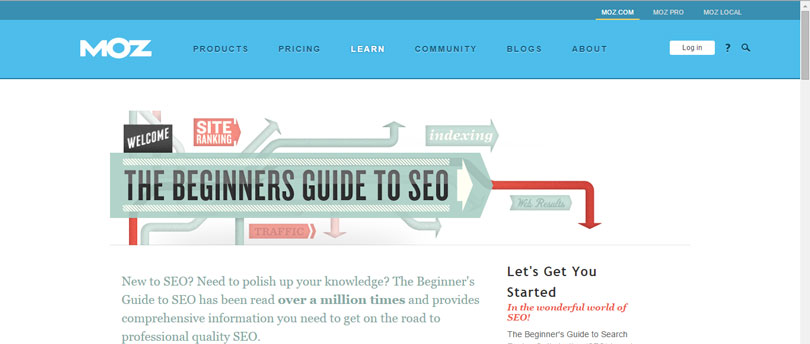
Like the one you are currently reading – Hard to produce, but worth every second. Length can be a subject of discussion, and while one topic requires more others are just fine with way less… Finding the balance takes both time and practice. And I’m not going to preach flowery prose, since this is my first one in almost three years. So there is that.
These guides are perfect for granting you authority on the topic, as well as attracting lots of links and social shares. Discussing the subject of SEO way early into this guide, we mentioned how links can improve your rankings within search engines. Well, imagine hundreds of them, all coming from reputable sources, pointing towards your guide. It can easily start to rank high for certain queries that will bring traffic.
We did the same thing with our workout reviews, and earned lots of money since. Made them detailed and topic exhausting and, in return, links were both easy to attract as well as create. Do some additional keyword research while you are creating the guide/ the resource, and the chances of ranking higher are way better.
However, even if you don’t manage to rank high while acquiring all those links, one thing is for sure- your Domain authority- an overall metric on how Google values your site- will increase, thus making it easier to rank higher for other queries with other pages as well.
Massive guides are created the same way you might go about creating a paper. Know your subject, decide the angle, and follow a certain structure. The more well-versed you are in your topic, the easier this process becomes, but it is essential nonetheless. Just for reference, I planed the flow of this guide for more than half an hour. Certain topics might feel more intuitive to maneuver around, and others might require a more robust approach- it is up to you to discover these parameters.
If you are concerned with SEO, remember this- Google folks are academics, so, the more time you invest, the more you apply yourself, the better the outcome. Things are maybe not that ideal now in the search world, but take it from a guy who follows search trends for year’s back- they will unquestionably improve.
Enough about the SEO angle, here is a massive article we created on How to books. The lack of links and shares shows that regardless of the quality, sometimes you will have to go out and make some outreach and marketing as well.
Case studies

These fall in the text realm as well, but you can spice things up by using charts, screenshots, and maybe even infographics. The design of the page layout can be experimented with as well. And guess what? People love case studies- A perfect way to reverse engineer a topic, and hence learn a thing or two.
I will go ahead and add two of them right at the end of this article. Gonna try to make them shorter than usual though.
Also, going to link back to Glen again, for he makes the best case studies I’ve seen so far. Learn from his example, and you are golden.
Interviews

Because people love them, right? Simply find influencers in your niche, and start pitching interview offers. Enough networking will land you a few, and you can even spice things up a bit and add some variations with visual design.
We had some success with them in the past. Finding people might be hard though, and harder still if you are aiming to connect them to your niche.
Here is how we made an interview with a husky kennel owner, and put a lifestyle design spin on the whole thing. Finding or creating such connections might make all the difference.
List articles

These are popular way more than I can describe here. And you’ve probably noticed by now – 10 ways to do this… 100 reasons why x is better than y. You can really get yourself carried away with creative ideas, and very likely to bring massive amount of traffic back to your site.
Facebook and StumbleUpon are perfect for such types of content.
Mash-Up articles
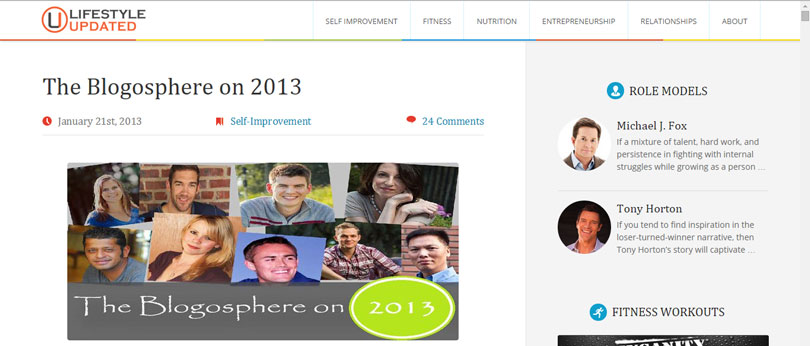
Mash-up articles are always fun, because you are featuring massive amount of info into a single piece of content. Take this for example- you are running a sneaker shoe company and trying to reach more audience. Simple.
Just make a mash-up article where you send one question about sneakers to hundreds of athletes. There are easy ways to find email addresses, or you can just shot them with the question on their twitter accounts. Once the answers come in- put them all together, add images, and make the best mash-up article.
“What brand of sneakers are NBA players wearing?” would be as viral piece of content as any. And this can attract potential customers, or even bring you links and mentions around the web, helping your SEO strategy.
Take a look at this article that we created two years back. It generated some decent sharing and links, but moreover proved that sometimes it is not about the content that you create, but rather how you go about promoting it.
Right now, we are planning to create a huge mash-up article on “How bloggers are keeping fit”. But enough with the transparency already…
Podcasts

These are a bird of another feather. I’ve seen many people elevating their brand on the net, simply by creating kick-ass podcasts. As a general rule of thumb they take more time to create, are harder to put together, and you will have to have a lot to talk about.
You can also interview people, or make the episodes bite size short like fitness legend Tony Horton does (His podcast is called the “bring it minute with Tony Horton”– obviously enough, it lasts for one minute only).
However, not going to lament too long about podcasts, I will send you to the one place where you can learn the most about them. Remember Pat Flynn we were talking about earlier? Well, it turns out that he makes one of the best podcast on the net, and has written an extensive guide on how to create podcasts.
They can bring massive amount of traffic, and if you think that you can handle the production part I strongly recommend checking Pat’s resource on the subject.
Video

Video captivates attention the most. And this is a fact proven by many metrics. The production, as we already mentioned briefly at the beginning, is not easy by any stretch, and it can require many attempts of trial and error.
I’m buying a Nikon D5100 camera as I’m writing this, and gonna start experimenting with this type of content format. Not having anything else to add on the subject of video, let me just say this- it allows you to leverage YouTube as a platform in order to bring more audience; and allows you to do all kinds of experiments with conversion optimization. The more production tools you have available on your disposal, the bigger the chances of creating more jaw dropping content.
We bought a GoPro camera for one of our projects, and started creating content on the go. You will be amazed how a weekend trip with your significant other might stack you with gigabytes of video material while mountain biking or hiking in the woods. Edit this material later, and you have some awesome content out of thin air. If you are the creative type and have a neck for video production (you might be and don’t know it) your content strategy will explode with awesomeness.
However, because editing tools can cost a fortune, and require a steep learning curve, your best bet may be an online alternative. Content professionals often use an online video editor to craft stunning content, without having to invest into a powerful desktop machine themselves. These solutions are intuitive, fast, and reliable, making video editing easy to start with.
Constantly search for amazing content formats
Follow sites, and use your best judgment to take a guess on whether you can duplicate what you see or not. Many times you will be pleasantly surprised with the results. This is how we started creating content in the first place. This is how this guide came to be.
I will introduce a couple of content formats for you to explore, only as a means to show you that you can really get creative with this process.
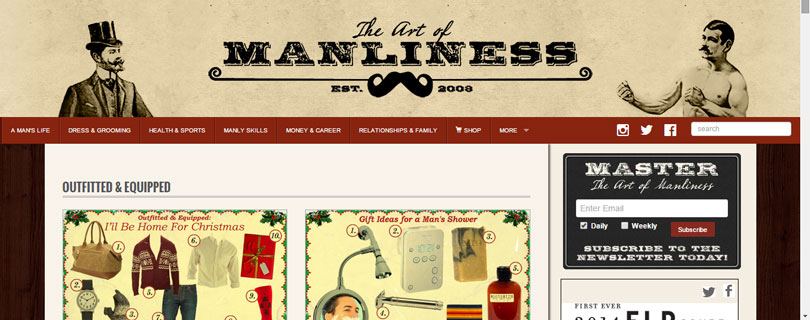
The outfitted and equipped article format that Brett introduced on one of my favorite sites The Art of Manliness serves as a great example on how to allow creativity to take you along the way. The great thing about having a specific content format is that it can generate ideas for future updates as well. Just look at how Brett did it.
And you can do this with anything really… Anything that is interesting and useful. Remember Moz and Rand Fishkin I talked earlier about- well, the Whiteboard Friday series really took off for them.
Search for interesting formats of content done right, and then fit many ideas into these frames.
Use different content formats for different platforms
Some platforms, depending on multiple parameters such as audience taste, as well as technical boundaries, prefer or even demand different types of content. Just as you cannot do well with audio material on Pinterest, you will fail miserably with podcasts on Facebook. Different platforms require different types and formats of content.
One thing you have to remember though, is trying to make them all pertain your vision about your brand. To tell, in one way or the other, the story of your brand, despite having different formats for narration.
Gianluca Fiorelli did an amazing job with his article on Transmedia Marketing, covering this topic from back to back. If you are seriously interested about content creation and moreover content strategy, I suggest that you read this with much attention.
FAQ
In narrating the story of your brand, every piece of online real estate matters. In fact, most efforts combine into one, thus strengthening your narration tenfold. And while many marketers scratch their heads, desperately trying to come up with something original, a quick stop to basics-vile station can sometimes be enough.
FAQ, or frequently asked questions, is a marketing archetype of decades past. Thing is, it works far better than you might think. What a FAQ page does is allowing marketers to easily present their brand, in the most time and space efficient manner. It can also help with directing visitor’s flow and answering most of the questions before they are even asked.
Waiting for someone to ask a question about your company, your brand, or yourself even, can become a rather long wait. Most of the time, such a thing never happens- people don’t seem to care. The FAQ page is a place where you make them care; giving the impression that it’s their curiosity running the show, instead of your carefully refined content.
Take Wait But Why’s FAQ page. Short and marvelously done, it holds your attention, making you scroll further down. They keep their voice consistent throughout, giving you a glimpse of what the content feels like. Also, in a very informal tone, you end up learning everything there is about their brand- questions that you might have down the road, answered before you even care enough to ask.
What I can humbly recommend though, is taking a more hands-on approach to visitor’s flow, starting right there. Namely, the FAQ page has the opportunity to keep one’s attention much longer, so why not leverage that as well? – Placing relevant links to important content, making the experience much more user friendly.
And this can work especially well for social entrepreneurs, and topics that are of a more political and ideological nature. Nonprofit and social movements are those who can leverage this tactic more than anyone else.
Kelsey Humphreys, a contributor to Entrepreneur, wrote a great article on how you can leverage the FAQ page, and why it is so important that you do so.
Now off to something totally unrelated…
Internet browsing experiences, I’ve been told, have a way of ending up, at one point of another, with cats. YouTube videos mostly, but this holds true for other venues and platforms as well. There is probably an equation somewhere, telling me that this is where you get to see a kitten. Being a reasonable fella, I respect the ways of the internet… So, here, a kitten.

Right before I walk you through the chapter of networking, allow me to redeem myself for taking away a whole paragraph’s worth of your time. I promised two case studies at the end of this guide, but having mentioned Wait But Why briefly, why not take a look at what they are doing as well?
Here, the mini case study on Wait But Why
Mini as it is, I will cut the introduction short, and start right away.
Wait But Why is your old school article publishing website. Run by Tim Urban and Andrew Fin, this site managed to create crazy amount of traction in recent years. Seemingly underdeveloped and lacking the flash of the internet design revolution, there is much to learn by taking a closer look.
I have a not-so-secret crush on WBW. The model they use for publishing and branding has seen a sharp decline of late. Namely, there are ever fewer sites competent enough to create content of such magnitude. And this is where the story begins.
WBW is all about great content. On what topic, you might ask? Pick one. The demographic group is hard to describe by using your filter entries only, and it goes something like this:
- 1. They are smart, curious and thinky
- 2. They are not that serious
- 3. They can’t be put in a box beyond #1 and #2
What unites them all is content so deep, so well-researched, and so uniquely written, that most stick around for good.
Divided in few categories, the main content is in the form of very, very long articles.
67 of them, several thousands of words each (not counting the notes within). Some of them even 20k+ words, simple page layout, and hand drawn pics in Paint… This is to describe the full scope of the content. Suffice it to say, each of them with 100+ comments, and 10k+ shares.
The other category, short mini articles called “minis”, counts more than 20 entries, with an average number of 30 comments, and 1000 shares.
Then you have the dinner posts, which is basically an open discussion that goes weekly, and manages to produce 300 comments on average. So far, there are 30 of them as well.
So how come a site with a single writer, which if you are naïve enough would easily assume non-profitable, is one of the most visited sites on the net?
Yes, you in the back?
- Really cool content and stuff, which separates them from all the rest and thus creates a brand.
Indeed.
The content delves into topics too distant to occasionally consider. This, along with Tim Urban’s specific style of writing, manages to appeal to most visitors. Curiosity kicks in, and you are likely to be hooked and mesmerized by the magnitude and depth of the content.
And when observing web psychology, a rule of thumb goes that most people will share something in order to make them look good themselves. Sharing Tim’s content says a couple of things about you:
- you are smart
- funny
- read cool stuff (thus know a lot of cool stuff)
- up to date on important evergreen topics
It also speaks volumes about you being a procrastinator, but that’s a thing for another discussion.
For now, allow me to explain how an avalanche works…
These articles, speaking to a very specific audience, get the word out on how cool WBW is. Having the demographic group in mind, assuming makes us realize how many influencers and early adopters are among them. Using English now, their audience shares a freaking lot.
Rand Fishkin, the founder of Moz we talked about earlier? Well, he once gave a presentation to a full hall of people, and mentioned one of WBW articles about the Fermi paradox.
Imagine the publicity, word of mouth, links, and social sharing that this alone has generated…
Thus far, WBW has:
- 103,000,000+ website visitors (tens of thousands per day as of late – noticed by following their on-site counter for a week)
- 161,000+ email subscribers
Only 48,484 a year back according to a screenshot of their homepage taken by WayBack Machine (content exposure exponentially grows due to social shares and link accumulation throughout the years – it has reached the tipping point and continues to speed up)
- 213,000+ Facebook fans
- 32,000+ Twitter followers
A peculiar thing to add would be that email subscribers grow faster than Facebook or Twitter fans combined together. I noticed this by following their numbers for only a few days.
And here is where a lot of these numbers come from:
Since email subscriptions are so highlighted here, you would assume direct traffic. And you are right – 46% comes from direct traffic according to Similar Web.
Search is shy with almost 11%, but I can go ahead and bet a growth there due to various reasons:
- More and more popular topics being covered (Fermi Paradox, How Tesla Company will change the world, artificial intelligence, solar energy, SpaceX colonizing Mars) – Made these clickable, so you get a sense of what quality content looks like.
- Articles about few countries that stretch into many, many words and are likely to rank high if given the appropriate boost and SEO attention.
- Brand searches going up over time
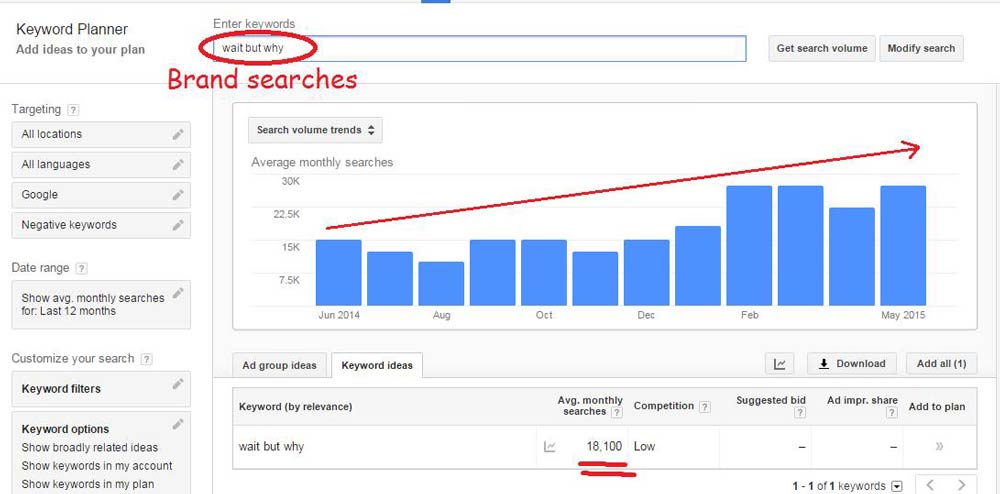
Social comes with 26%, divided almost equally between Reddit and Facebook, and a small percentage of traffic coming from Twitter.
Referral sites come with 15%. Some of them include Fast Company, Business Insider etc. (imagine the weight of the links)
Getting the scope of how authoritative this site is, you can just look at their link profile and discover:
- 114,947 inbound links, from 5,550 referring domains.
Besides, the content is very long, specific, and thus far surpassing semantic relevance of many other competitors (i.e. likely to rank better as time goes by). They also link outwards as well, citing many reputable sources (something much recommended by Google).
And this is all because of great content. Content that sometimes takes months to create (research, writing) and is consistent in style throughout.
If you open their FAQ page, there is much of what we talked about earlier conveyed in it. Same goes for the about page, and even the tiny turtle you can click at the bottom of their site right there in the footer. This is branding done right. Now reverse engineer some of that for your project as well.
What is also worth mentioning is investment in content research. Tim once sent a question to subscribers, asking them in which country they wanted him to go and write a long article about. This resulted in a long-ass trip in five countries, and long-ass articles about them afterwards. They all got amazing social buzz and mentions around the web. He also visited Elon Musk briefly, and took notes while on a field trip to Tesla factory.
Bottom line, investing in your content offline is as important as investing in your content online. Creating quality takes away more of your time, but brings huge rewards later.
Holy fruit salad Batman, I forgot this was a mini, mini case study…
Wrapping this up in a minute, honest.
Having such an online giant in their hands, what are they doing about monetizing?
Being smart…
Instead of ruining user experience by aggressively trying to monetize, and thus weakening their brand in the process, they’ve managed to make monetizing seemingly nonexistent.
You have the store selling posters, mugs, T-shirts, and squishy things, and some free goodies in there if you are curious enough to look around.
Then, you have the e-book, which is basically the whole of year one glued together and sold for 4$ (over delivering, always). And finally the donate button, which I suppose is doing great, and brings them some decent numbers in revenue.
This is how you leverage the donate button. Learn from them. By creating great content, caring about your audience, and keeping the site free of obvious and intrusive monetization methods.
Quick update on monetization. They also joined Patreon (described below, in the chapter on monetization) and are now earning close to 9000$ monthly via donations through this platform alone.
Another cool thing they did, with the SpaceX post (one of the best pieces of content floating around the entire internet) is offering a PDF version of it, for the price of 3$. This is a very useful tactic to leverage, since it allows you to generate some income on all of your articles, supposing they are A) awesome, B) evergreen, and welcome large amounts of traffic over time.
Mini being mini, I think that was enough… Off to networking.
Networking
Some people have a knack for it, and others find it to be excruciatingly hard. I’m covering middle ground here. I always leave networking to my partner, and try to stay in touch only with people I’m following closely. If you need connections in the offline world, the same is true here- only tenfold.
You can keep in touch via mail, Skype, Google Hangouts, Facebook, and simply by going where they publish stuff and comment. Trust and friendship are built over time, and there are no shortcuts around it.
Here are few easy ways that might bring attention from an influencer.
- Comment on their work
- Share their work on social media
- Mention their work whenever you can within your own (the way I did numerous times throughout this guide)
- Follow them on Twitter and Facebook and strike up a conversation whenever you can
- Be honest and sincere
- Try to give back something of value, instead of just absorbing things selfishly
- If there is no connection, and you cannot see how the two of you can strike up a conversation, nor can you link them to your work, be honest and ask for favors directly- nobody wants people who fake it, and most of the guys working online can easily spot such behavior
- Don’t expect that when you follow someone on Twitter and say hello, he will do you a favor in return- such things happen only when dating, and usually require a lot of alcohol to be involved
Be sincere, and try to connect with people without any additional intentions or hidden agendas, you will do just fine.
Social Media

Observing our stats throughout various social media channels, you will see that social is not our strongest asset. Far from it, in fact. However, it earns a spot in this guide just as much as anything else does.
Statistics on social media platforms, being under a process of constant change and flux, it would be very unproductive listing them here. Besides, I would have to return to this guide every now and then in order to correct them.
The reality of social is that every platform you can think of has enough audience to support your brand, and then some. Making your presence there and getting strategic about how you publish content is a science though. A science you will have to learn through and through if you like to strengthen your brand or bring traffic to your site.
Pinterest, Facebook, Twitter, LinkedIn, StumbleUpon, Instagram, Google+, and even Reddit, Quora and many others… They all require a specific approach, and offer many opportunities respectfully.
And here is how I’m going to deal with this chapter- Since we are all more or less familiar with how social channels work, and some of us are even quite the wiz, I’m not going to devise a singular strategy by myself.
Social media marketing, same as search marketing, is a vast field on its own. Every platform you will make your presence on requires not only on-paper knowledge, but much trial and error as well. In order to familiarize yourself with the basics and build your way up read the beginner’s guide to social media by Moz.
Mail outreach
A huge part of networking can sometimes come down to knowing your way around the inbox. Writing mail outreach is a crucial skill, and a reason why some virtual assistants get to earn so much.
And while writing emails can be intuitive enough for some, knowing how to acquire them can become a piece of work. This is a very strange thing to say, I understand, but we are all very illiterate when it comes to structuring the perfect mail – Myself especially. And instead of saying that I know what I’m talking about here, sending you off to other resources seems more appropriate.
- Voila Norbert, Conspire, and Full Contact (check these three out)
- This right here is golden, read the whole thing, and then read it again. (print the page immediately, for you don’t know how long it will be around for free) Thanks a ton Austen Allred.
- And when you end up with a boatload of emails, reading this gives you quite a different perspective on how to approach people. Courteously of Brett McKay.
Note from author
If this were to be a TV show, the chapter ahead is like one of those episodes that you have to record and then re-watch again.
If you are thinking about starting an online business, what follows ahead will give you more ideas than you can chew. Each of them tied with an existing example so that you can easily wrap your head around it.
Monetization
I bet you’ve waited for this chapter, and here it is finally. Turning the pretentious alert on – I think that I can write a book about monetizing. However, having in mind that I only leverage a couple of monetizing methods, this tells a different story. Knowing the types of monetization methods that you can implement to your site, is one thing; but actually doing them- that is a bird of another feather.
It takes a lot of dedication to follow one method till it makes some buck, and then continue to religiously devote time to the process. Some of the methods I’m about to describe require more time than others, but then again they bring a different amount of revenue as well. Choosing the best monetizing method for your site might take some trial and error. Again. You will, however, have to consider your strengths and weaknesses, and that is hard to do in an industry where you are stepping your foot for the first time. Things will eventually get there though.
Enough chatter, let’s go over a couple of methods that will make you dollars.
Affiliate sales

The reason why I’m placing this first instead of selling your own products is very simple and straightforward actually. Third-party products, saving you time on the production end, make it easier to set up your shop.
The idea here is to sell someone else’s product on your site, and earn affiliate revenues. There are a couple of ways you can do this, but before we go over them, let us first explain why affiliate marketing and why not. Take notes here, this is important.
Why affiliate marketing?
As I’ve already mentioned, affiliate sales take less time than selling your own products. In the production phase, that is. However, there are many other advantages as well.
First thing first, you don’t have to worry about any customer service, or payment processing, or delivery or whatnot… All is handled by your vendor. You- you just have to sell.
Another thing that makes affiliate marketing so darn easy is promotion. The product that you are trying to sell… guess what- it has probably already been promoted to death. Take our examples if you like – we are reviewing products that already have a very large number of search traffic, i.e. have been promoted rather hard.
Having done all the marketing for us, we just tip our hats in gratitude, and start selling.
Besides, affiliate marketing offers can be found in millions, regardless of your niche. You will just need to come up with creative ideas and be constantly on the lookout for new offers that might be relevant to your audience. You can recommend a single product, or make reviews about products that you already use (like this Fit Tea review), and duplicate this process millions of times. Pat Flynn, the guy I mentioned above – he is making tens of thousands of dollars per month with nothing but affiliate sales. Inspiring, huh?
Drink your coffee slowly now, because we will return on the ways you can sell affiliate products, I promise. But first…
Why not affiliate marketing?
Right when I hope that I’ve swayed you towards the idea of affiliate marketing, here is a list of reasons why this method might not be the right one for your business.
While some offers might go as high as 75% from the earnings, others tend to go really low- imagine like 10% or less. This, of course, depends on the industry and the amount of energy that has already been invested into marketing. For example- if some product is popular, you are likely to net somewhere around 10-15% of earnings. The less popular a product is, the bigger your bite from the affiliate pie.
Also, many people start having trust issues with your brand the moment you make it a habit to endorse other third-party products. Even writing about this, I know I’m losing some percent of my revenue. You see, many people believe that in order to earn money, you are trying to sell them a product that is the equivalent of snake oil.
Hence, recommending products is a viable option only when you are endorsing them because they are fulfilling some of these criteria – The more, the better.
- Are relevant to your niche
- Are relevant to your audience
- Are good products
- You are not doing it for the reason of getting paid only
- You’ve tried them for yourself and can vouch for their quality
- You are being transparent with the affiliate angle
Ways to do affiliate marketing
This being our primary source of income, I can honestly write a book about it. Thing is- nothing is that much complicated when you think it over. There are millions of ideas on how to sell affiliate products, but most of it stems down to creativity, really.
Here is one more advanced way to do it (a guest post of mine about pre-launch affiliate marketing).
Being smart, you will want to make the affiliate offer perfectly blend in with everything we discussed so far. The less obvious the affiliate angle is, the more likely you will make sales. If your readers trust you (whether that is sincerely or you manipulated things by using conversion optimization to the max) they will not have any problem when deciding to buy from your affiliate link.
Here are a couple of ideas though:
- Write reviews about products that are relevant to your audience. Reviewing high heel shoes on a site about American football doesn’t add up. Think smart about creating connections.
The great thing when it comes to reviews though is the fact that visitors are already sold to the idea of buying, and really just looking for a way to justify reaching their hand for the wallet. And reviews are best leveraged when ranking them high for the exact search query- {name of product} review.
If you use the products yourself, the reviews would be even more detailed, and if you happen to choose only quality products to sell, this process moves beyond easy. We did the same thing when trying to review fitness products (The P90 workout review the Insanity Max: 30 review).
You can do something similar yourself- pick a quality product, use it for yourself, and then go ahead and write an extensive and honest review about it. There is no need to manipulate people- there is always something good to sell if you look carefully enough.
- Recommendations are also a great way to do affiliate sales. And it is even that much easier. If you already have an engaged audience, you can simply recommend the product, and if they trust you enough chances are that you will make sales. Making it less obvious though, you can offer an informational resource about some area of your niche- a huge piece of content- and inside, list all the tools people will need in order to use what you teach.
For example – In this “Teaching you how to do business online” guide, I can go ahead and list many tools and software that you will need, some of them being affiliate links. You get the picture.
Remember Ramsay from BlogTyrant whom I previously mentioned when talking about building audiences with your blog? Well, he does this in a very intuitive way. Just read his impressive guide on how to start a blog, and you will notice how there are affiliate links placed just where they make sense from a user experience point of view.
- Another way to make affiliate sales is to find a product or a service that you wish you had thought about creating earlier. Imagine this- if you are running a fitness blog, and don’t have enough resources in order to create a product- say, a workout video- why not search for some already existing product on the market, similar to what you wanted to offer, and sell that instead?
This applies to other industries as well. For example, when we started Discovering Macedonia – a tourism site project, we discovered that it was in the best interest of users to offer them a chance to book accommodation directly from our site. Unable to provide this service ourselves, we decided to go with Booking, and promote listings from there instead. For each reservation we earn affiliate revenues up to 4% (Hey, what’s up with all the transparency, huh?!)
Creativity guys and gals, creativity… The more projects you analyze, the more ideas you will eventually come up with. Having said that…
Exercise #7
Try analyzing a couple of sites where you can find examples of affiliate marketing. What type of strategy are they using? Can you tell for sure?
Also, try and think about how this type of approach can be used for your idea as well.
Affiliate networks to join
While it is wise to strike a deal directly with a company, without having to bring a middle man in, many times this proves to be next to impossible. Some companies don’t have affiliate programs, and others would require more of a proof in order to get in into theirs… Whatever the case, there are affiliate networks that allow you to sign up for free and start promoting the offers from millions of companies.
I will list three networks here, which albeit not exhausting the list, are more than you will ever need.
- Commission Junction (affiliate by conversant – I think this is their name now)
- Max Bounty
- Click Bank
Each has its own pros and cons, and if you are interested I suggest Googling them one by one.
Amazon has a great affiliate program as well, and if your site settles in a broader niche- or one where you can sell many related products to your main offer, then it will work perfectly well. The other great thing about Amazon is that once you send a visitor to their site, whatever he ends up buying, you are being paid a commission for. And being one of the most tested sites in terms of speed, UX, and conversion optimization, this is saying a lot.
Here is a complete guide on how to sell products on Amazon by Darren Rowse.
Selling your own product
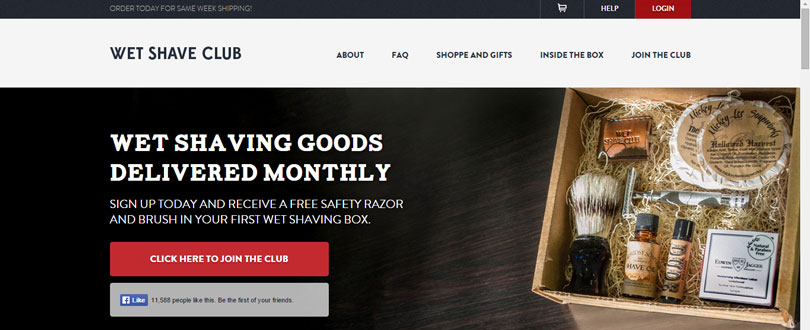
This monetizing path is followed by many online marketers at one point or another. Figuring out that a single e-book can bring in some rather serious cash, people get carried away with it. For some, it works- and works well.
Product creation is an industry on its own. And many people wrote extensive guides about it. The fact is though, that the more versed you are in your own niche, the bigger the chance that you can create something worthwhile. Either that or you have a real neck for creating things out of thin air. You can even outsource the whole thing and simply concern yourself over sales. Oh, the options…
And before we go on to listing different ways on what you can sell, just take a look at this guy and his site about Food Trucks. Yup, that’s Pat Flynn, the same guy from above – you know, the “be everywhere dude”- well he is in fact; He is everywhere.
He firmly believes that you can make a business out of every niche idea if you dedicate yourself enough. Wanting to prove that to his audience, he took the challenge to build a site about food trucks and make a business. Just like that.
He wrote extensively about this project on Smart Passive Income as well. The site can easily be used for a case study covering almost every aspect of online businesses discussed in this article. Not making this another formal exercise, you should check it out though.
It is also a great example of how to choose your niche. As Pat says- go an inch wide and a mile deep- meaning, to choose a narrow niche, and exhaust the topic.
So where were we? Oh, yes, products…
You can start by searching for a niche that has a lot less competition- though this is never a real requirement. Having a product, half the job is already finished. If the product is of decent quality, it becomes much easier too. You just need to find a way how to sell it. And having in mind all the chapters we discussed above, this should already be easy to comprehend.
You will sell products on your site- setting up a landing page first- but the options on how you sell them are limitless. The email list can be used along with the automated sequence; or you can offer them to other people giving them affiliate fees; you can set up a YouTube account and attract visitors with video material, later on sending them to the landing page… Really, the options are limitless.
So what type of products can you sell?
E-books

These have always been a very easy, yet profitable to sell on a website. Still are, by the way. If you can write a good book, or hire someone else to do that for you, make it look good with editing… It can go a long way.
The great thing about e-books, in comparison with other type of products, is the time frame in which they can be made. Granted, some people would spend more time writing a good book, than other creating a crappy app, but as a general rule of thumb, books are easier to put together.
Find a topic where you have something to say, and start writing. Or outsource if you like. You can also reverse engineer this whole process, and look for successful e-books, trying to copy their approach- an editing tactic; how they write headlines; from a design point of view… The same can be done when trying to sell as well- find examples of people doing it right, pick one approach for yourself, and dedicate some time to the process.
Video Course
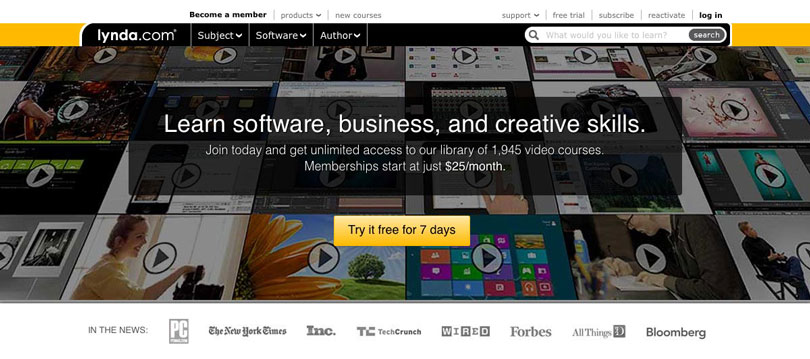
Same as with e-books, since a product is a product, video courses (or video products… said products too many times, haven’t I? well…) can range from being easy to make, all the way to having to buy Hollywood equipment in order to produce them.
Here is a (pretentiously) transparent alert- We are hoping that one day there will be a fitness video product released on this very site; planning, in fact. And having familiarized ourselves with every step of the process even before we start filming, I can honestly tell you that it is a bird of another feather. Making a video product, depending on the quality, can be the hardest thing you’ve come across. But then again, it is still manageable even if you are a total amateur- like we are.
Being perceived as of higher quality than an e-book, it can be sold much easier, and even that much more creatively.
An App

Because everybody is making them, right? An app is like any other type of product, where the process of putting it together can range from fairly easy, to excruciatingly complex. You can outsource, sure, but it will generally cost much higher than say, publishing an e-book.
The opportunities for marketing-done-right are more numerous than the both of us together can come up with within a million years.
Besides, you can place your app in the app store, and expose yourself to a whole new market. The same can be done with e-books on Amazon.
A Physical product

Having in mind that we are discussing online businesses here only, this is kinda more of a merge between the online and the brick and mortar world. In this case, your online aspect of the business would be still there, while changing digital for physical goods. I went too broad here, so I must digress…
The truth of the matter though, is that regardless of the format of the product, the better it is, the better it sells. And there is hardly any way around this.
Some examples of business models and ideas
Not trying to exhaust each example separately, I’m only going to list a few of them, and explain things from their basics.
A standup comedy online business
- Filming or recording a couple of gigs
- Setting up a site
- Making a presence on YouTube and posting material there
- Creating profiles on Facebook and Twitter
- Bringing visitors to the site from these channels, and converting them into buyers of your recorded material, after setting up a payment processing system.
Note: each of the steps can range from taking few hours to create, to years of practice and a lot of equipment and rehearsals.
Handmade gifts e-store
- Making or buying the items
- Setting up a site
- Making a presence on Facebook and Pinterest
- Maybe even making a presence on YouTube where you film How-to videos about creating DIY gifts and various items
- Bringing traffic to your site
- Setting up a payment processing system and selling your products
Note: as with the previous example, each step of the process can vary rather much in regards to time and resources, as well as skills. There are even additional methods you can apply- like playing around with sponsored ads; or writing articles around the web in order to raise brand awareness, just to name few.
Merging a physical and online business – A recipe store
- Making a visually captivating site, with lots of pictures of food and meals
- Asking for payment in order to sell the recipe and deliver the exact ingredients
- Making a presence on Pinterest, Facebook and maybe even YouTube
- Writing for food blogs
- Bringing traffic to the site and sell recipes along with ingredients
- You will have to make sure about packaging, delivery as well as processing payments.
Note: You can hire a renowned chef, create various packages (vegetarian, Paleo and so forth…) pay in order to be featured on popular sites about food. Taking this too broad…
Creating a game and selling it online
- Create or outsource the creation process
- You can even run a Kickstarter campaign like the one a friend of mine did (The Seed game)
- Make your presence on forums
- Make sure to be featured or interviewed on popular gaming sites
- Invest time into marketing (give sneak peak material, trailers, and write on various publications around the web promoting your game…)
Note: I probably got carried away with this, since some aspects of it are science fiction indeed, and my friend and his team took months of very dedicated and work in order to produce something worthwhile. This is just in order to familiarize you with all the diverse opportunities when it comes to online businesses.
Membership area/forum
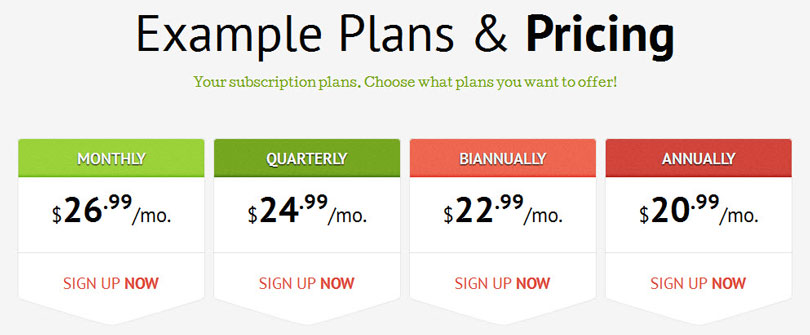
My knowledge when it comes to membership sites extends only to what I stumbled across while browsing the net. Having a curious mind, I’ve figured that it perfectly blends with everything else so far.
You can create a gathering place for aficionados of a certain niche, and thus charge entry. Think of this as an online analogy to opening up a bar.
You can also spice this up a bit, and abandon this traditional concept of membership sites, while creating something else- premium content that people must pay for in order to be able to see. If you are good at creating content, this can be a piece of cake.
I can reverse engineer the whole process of this, along with marketing and whatnot, but what fun would then be in it for you? Here- in order to familiarize you with all the opportunities (and there are many if you know where to look), I will just include a very long and in-depth case study of a membership project. Kudos to my buddy Glen for putting this together – A poker membership site case study – This post is a very strong recommendation, and I would sincerely love for you to read it. Not only will you familiarize yourself with membership projects, but you will find millions of cross references to what we already shared so far. Think of it as a perfect case study where you can find everything that we’ve covered in one way or another. Make it a formal exercise if you will. Yup, exercise #8.
Publishing ads
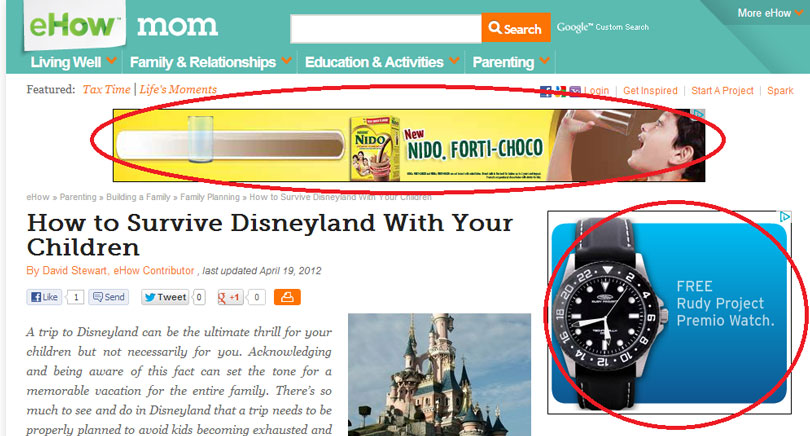
When you sit down and talk to someone who is new to online businesses, this is pretty much what you get- “I will open up a site, bring massive traffic every month, and charge for ads. Not a single worry in the world…”
And while some take this seriously and eventually monetize this approach, many others struggle while making pennies. In order to create serious income streams out of selling ad space, a couple of things have to be covered first.
- You will need a boatload of traffic, and a site with so much content that this traffic that you bring stays, and actually spends some time there.
- You might also need some serious testing with design, so that people click on your ads.
- You will need organic traffic from Google, or referral from Facebook; or an engaged and loyal audience.
There are many other parameters too, but even the ones that I’ve listed so far depend heavily on the type of ad placement you will decide to go with.
For example- click-bait headlines and click-bait content are perfect for CPC ads (cost per click- like Google Adsense). If you are bringing a constant stream of traffic, supposedly from Google, or a well-established Facebook Page, you can also consider CPM ads (cost per mile – paying you a certain amount- from 0.2- 3 or so dollars, once you reach 1000 page views).
And while certain types of sites are perfect for this model to work, others are less so. For example- Lifestyle Updated averages somewhere around 120,000 page views. If we were to follow a formula where 1000 page views bring us a dollar or two, then we would’ve been long out of job.
There are always better methods to monetize from your visitors, as opposed to publishing ads; though some sites bring in millions of revenue. Huge thanks go to Glen again, who took the time to sit down and analyze one such site to the bone. The whole model is explained down to such detail, that you will instantly want to jump on board and try this for yourself. At the time of publishing this, it really took off and created some rather serious buzz.
Having in mind that it is far easier to learn the ins and outs around ad publishing than anything else, I will keep this chapter short.
Offering services
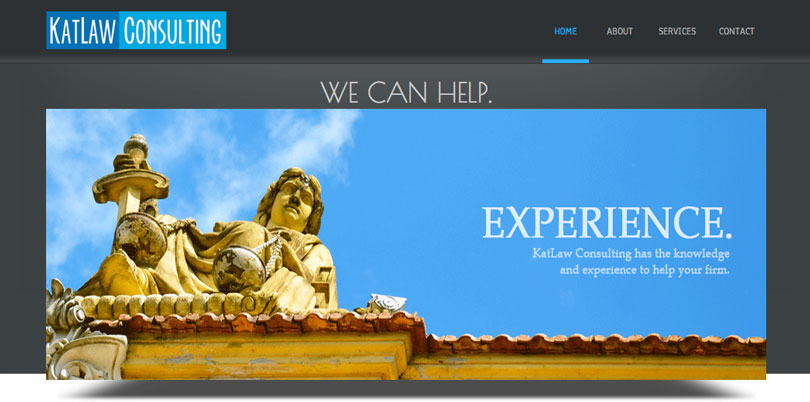
I’ve seen many peers settling down for consulting jobs on the net. They are good at something, create a site that leaves the visitor with that exact impression, and start offering their consulting services – A lucrative approach indeed, and very profitable too, if you don’t have a problem with abandoning the “passive” model of income.
This is coming from my perspective, sure, but offering consulting services, in a way defeats the purpose of doing your business online. It is a viable option nonetheless. You can eventually end up with hiring more people and taking your company to a higher level.
What type of services, you ask? Anything you can think of, really…
Design, copywriting, ghost writing, coding, video editing… Even medical and law advice. If you can sell it, people will buy it.
Not very familiar with this type of business, I will go ahead and paint you a vague picture of what is required:
- A site that attracts targeted traffic (people who are directly interested, or might be interested about your service).
- This site should leave the visitor with the impression that you know what you are talking about (social proof, mentions around the web, testimonials, professional design…)
- A blog-like area where you teach people for free, as to establish yourself as an authority on the subject.
This is rough sketching, I know, but more or less a perpetual frame many other sites are using.
Promoting your offline business

Say you are a wedding photographer, and you are using your site in order to land more clients. Perfect. Using your creative capacity, and the boatload of text I already shared so far, it is a matter of personal choice how you handle this.
Some might decide to go with portfolio type of sites, bringing traffic from Facebook fan pages or Pinterest profiles; while others might create a blog where they teach other people how to take perfect pictures. There is no single right approach to this.
Ramsay from Blog Tyrant interviewed one of Australia best wedding photographers, on how he uses the net in order to improve his business.
E-store
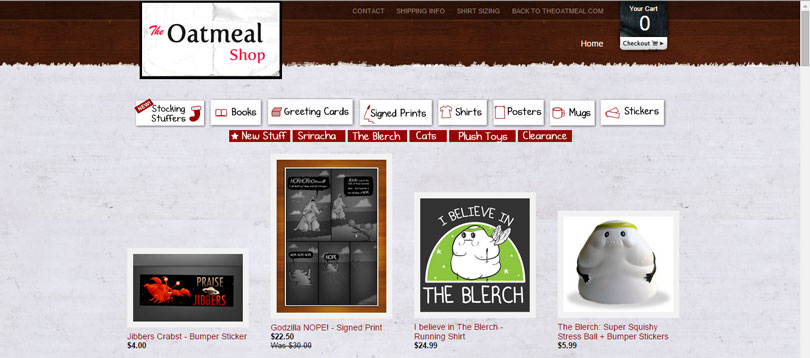
Imagine this scenario – your site is eventually coming to a point where people fall in love with it. They love your brand, the vision behind it… And guess what- whatever you have to sell them, they will buy it.
T-shirts, coffee mugs, various products wearing your site’s signature…
That’s right – many webmasters have created an engaged audience, and have found that people really love their brand. So, in order to monetize from this fan base, they started selling products. The audience loves the chance to purchase a signature product, and the webmasters offer exactly that.
There is some product creation, money processing, and delivery involved here, but if you think you can handle this, some decent money might be on the table.
Here is an example of someone doing this right.
Donations
Truth is, and always will be, that mapping pricing strategies is hard. So much so that very few online entrepreneurs are comfortable enough creating them. A lot of conversion optimization techniques, as well as beyond decent knowledge of web psychology is required. Some operate on a more instinct-based gut feeling, but that too is rooted in many years of trial and error.
And while you will reach only a certain demographic group with one strategy at a time, there is no need to label your customers by the numbers. Everyone can enjoy your work, deciding, separately by himself, how much to chip in for the value received. That’s what the donate button strategy serves for.
Here are few guidelines to point you into the right direction.
- Suggest a small number, or make the sum appear into the chart as a default. People can change it by a single click, or by typing their own number instead. What this helps create, is a perception that majority of folks are chipping in a similar amount, if not more. 3$ is usually the norm, but you can try and see how well it converts. My approach would be to make the number appear only after the donate button has already been clicked. Again, this is not a stone-written rule, but an idea that can go under further A/B testing and additional conversion optimization.
- You can also make a drop-down menu; just like the one you see when you move the cursor over, in order to change the font size number in most typing tools. Or, you can be creative, and add a little something right next to each amount suggested (10$- If I somehow know your identity, you are in the part of my audience that I might hug on the street out of the blue willy-nilly)
- Keep the site clean, with no obvious signs of monetization. If visitors arrive to the conclusion that you are making money by ads or whatnot, it is harder for them to donate – the reasoning goes that you are already making profit, so there is no need to go further by extending additional generosity.
You can also visit Patreon – the subscription model for donations, if you so prefer. You know how few centuries back musicians would play or compose on the court of some Duke or whatever? And while doing that, the owner of the property was usually paying for all of their expenses, wigs included…
That’s exactly what Patreon is, only decentralized. It is a platform where you showcase bits of your work, and people pay you monthly, in the form of donations, in order for you to be able to continue doing what you do best.
You only have to sign-up, create a profile and link to your work (be that YouTube videos, text articles like this one or whatever you might think of). Then, just drive traffic to that Patreon page- preferably fans- and you might start to earn a monthly payment for simply doing your work. Wait But Why, from the mini case study, they are already doing great there.
Besides, this is a great platform for those who don’t want to implement any straightforward or obvious monetization methods within their work. It is also great for social proof.
Kickstarter
In line with the donation mindset, you’ve probably heard about Kickstarter. This is a platform where you start a campaign, talking about your idea, asking people to chip in in order to make it happen. Many times, Kickstarter campaigns have a way of turning into pre-sales of your product or service.
There is no limit to what you can pitch. Membership sites, software, hardware, apps, physical products like say card games… It’s up to your imagination.
They have the best team that will help you in creating your pitch bulletproof, as well as further advance your idea and marketing angle. If you only knew the extent of jaw dropping case studies I’ve read about projects that went through the KickoffLabs platform.
In order to get yourself familiarized with Kickstarter products, browse the categories, and see how it works.
Money Withdrawal
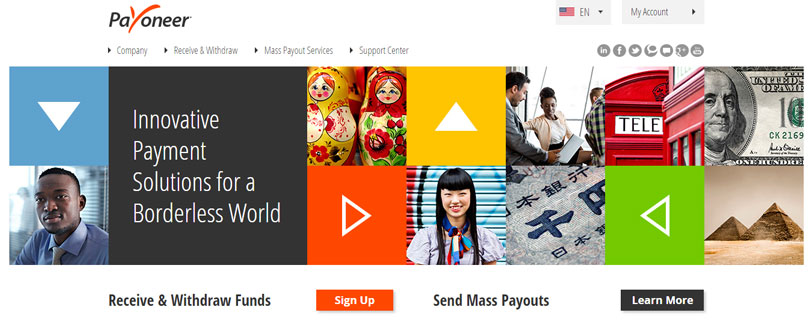
For those of you living in the States, this might be a very minor issue. The complexity of it though, rises exponentially when you consider international money transfer, as well as taxes. Put some virtual and futuristic currencies in game a year from now, and there is the need for yet another guide on this topic.
Don’t worry; I will try to be brief.
There are different options of getting paid, and most networks you will come to deal with are usually open to few. Payment via check, wire transfer, services like PayPall and Payoneer that help speed up the process.
PayPall is the golden standard so far, but there are countries around the world that still cannot feel the benefit of this company. A great alternative that comes to mind is Payoneer, and we use it for all of our payments. They even send you a MasterCard tied directly to your account which you can use wherever there is an ATM around the world.
As for taxes, it depends on your country of residence. Each has its own laws and regulations, and you will be better off not figuring out a way around them.
Hey, after all, Bitcoin takes over, and we are going tax free. Hurray… That is another advantage to having your business online- most of the trends are happening there, and you will be the first to feel the benefits.
Giving back
Not pretending I’m a huge philanthropist here, don’t get me wrong. However, there is this trend of webmasters trying to figure out one way or another to give back to society. Whether this is by raising money for charity, giving something out of their pocket, or teaching valuable skills to others…

There are three reasons why I recommend this.
First of all, you are doing a good deed. This can be argued back and forth to the point of exhaustion, but I personally love to be able to give something back without anything in return. It turns out that most of the people I’ve met working online share a similar passion for this as well.
The internet is all about swag- so this can be a great opportunity to not only help someone, but have your face out there- after all we are discussing business here.
And finally, focusing on the act of giving back, you are likely to devote some time to the process, and neglect other random and haphazardly appearing ideas that might kill the focus necessary for your project.
Giving back, on the net, is even much better, since it is likely to ignite a similar behavior from most people watching. Your campaign goes viral, and there is no limit to what you can achieve. See this example of how Pat Flynn donated himself, and managed to raise additional money for building two schools in Ghana.
And don’t you concern yourself too much over numbers and methods – giving is giving, regardless of how you frame it. Or as Tim Ferriss says in his Four Hour Workweek:
Before I start chaining myself to trees and saving the dart frogs, though, I should take my own advice: Do not become a cause snob. How can you help starving children in Africa when there are starving children in Los Angeles? How can you save the whales when homeless people are freezing to death? How does doing volunteer research on coral destruction help those people who need help now?
Children, please. Everything out there needs help, so don’t get baited into “my cause can beat up your cause” arguments with no right answer. There are no qualitative or quantitative comparisons that make sense. The truth is this: Those thousands of lives you save could contribute to a famine that kills millions, or that one bush in Bolivia that you protect could hold the cure for cancer. The downstream effects are unknown. Do your best and hope for the best.
If you’re improving the world – however you define that – consider your job well done. Service isn’t limited to saving lives or the environment either. It can also improve life. If you are a musician and put a smile on the faces of thousands or millions, I view that as service. If you are a mentor and change the life of one child for the better, the world has been improved. Improving the quality of life in the world is in no fashion inferior to adding more lives. Service is an attitude. Find the cause or vehicle that interests you most and make no apologies.
I guess I had to include these paragraphs too, so there. Remember to give back whenever you can, and know you are doing the right thing.
Distractions and setbacks
As with any other venture, and any other creative field of work, you will be distracted. The net, with hundreds of rising trends, will make sure you do. The real trick though lies hidden elsewhere.
The online environment will leave you with the impression that things can happen overnight. And though some of them do, most success takes several years of dedication and just as much of a work ethic as for any other line of work.
I cannot pretend to be an expert on any of this, but some things I’ve learned from experience.
- People will want you to join their projects. Like it or not, most guys working online have a much more volatile nature than their peers in offline verticals. And simply because you are sharing a similar environment, doesn’t mean that your businesses complement each other. This is a trap I’ve brought myself and my partner in far too many times.
Know this- being online, by itself, doesn’t create much similarity. Same as with brick and mortar- you sell shoes, some other dude skirts- It is similar, yes, but far from same.
People will try to convince you that you can join their project, because “Hey, we are doing the same thing, and together there is huge potential”…-Knowing when to turn down offers, because you understand that you have your own thing and other people theirs, will save you from burning out too soon. Sometimes it will simply keep your paycheck less volatile, and yourself sane.
I had to learn this the hard way, and rather late. Thanks to god I did learn it though; having someone who will slap you on the face whenever you lose focus by your side, is great too.
- Knowing how online businesses work doesn’t cure cancer. So stop trying so hard to “sell” your skills to other people, businesses and projects. This is another one of the many distractions you are probably going to face. Work on your own thing first and stop procrastinating. Ideas will come and go, and chasing them might mean the end of your business. Be careful.
Case studies and closing note
Wrapping this up, I cannot think about anything else to add without expanding a few thousand words more. Here is the thing – this is a constantly evolving field, never fully exhausted by a single book on the subject. The guide’s title, for what I hope, fits perfectly- a beginner’s introduction to the vast topic of online businesses. The rest – it is all up to you.
Whether you take one road or another, things unfold differently. One example I always stress particularly is within the field of SEO – the most authoritative book on the subject, by far, and one aimed to help beginners and more advanced professionals alike, called The Art of SEO, is 716 pages long. Reading it once, is usually a good start if you’d like to work within this field. But then again, search engines evolve on a day to day basis, so you’d have to read blogs, adopt a lot of trial and error, and then some. And this is for SEO only… Other verticals usually require the same or even more effort.
My point being, if you want to know everything and be a one man show with a valuable set of skills, it takes time. And you should be comfortable with this for the most part. Take our story for example – we started three years back, not making a dime for the first one and a half. Alas, we weren’t serious about it, and could afford the time luxury on the fact that we were students. Things change, and now I cannot imagine working on a project that fails to earn revenue for more than a couple of months.
But most online entrepreneurs started in a similar fashion – Learning the skills for a while, implementing them on one project or another till things took off. It is a pursuit of a lifetime for some, so one or two years is a fair trade when you think about it. College takes more and you are left with a huge dept. Not saying anything – just for perspective.
As far as educating yourself goes – take this into consideration: there is still no course on any university that I know of, teaching you about online businesses. Many have tried, but I would be seriously surprised if I see even a single class graduating within the next few years. This thing is moving at a rapid clip, and faster than a speeding train. Education, for what we see thus far, is unable to catch up. Not to worry though – a formal degree is never required. Many of the guys I link to in this guide are college dropouts- again, just for perspective.
At the end of this guide, you will find a small list of reading material that might help you with various aspects of this line of work. Heck, I will even throw in some motivational material in there- for you will need it. If this guide achieves just as much as referring you to a single authoritative source on any subject connected to online businesses, I consider my job done (and waiting for you to take me out for a beer. I’m free on Thursdays, so…).
Finally, apologizing for my non-formal tone, I hope you don’t feel like I’ve wasted your time. The two short case studies I’ve promised are right below, and there is really nothing else to add. I will however leave you with a single advice- this is a volatile line of work so regardless of where you work- home or an office- things tend to move fast. My advice- find an anchor. Be that a routine, or a very devoted approach to your work, just make it a habit. You will not only get more done, but remain sane during the process. Btw thanks to Pat Flynn again who recommended meditation (go Headspace).
Here, I leave you with two case studies – one about a favorite site of mine – The Art of Manliness, and the other about a meditation app that I love the most – Headspace.
The Art of Manliness case study
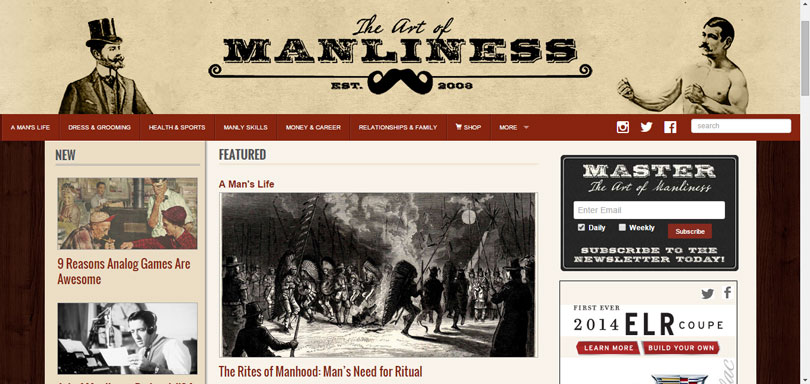
Observing other online ventures, as we’ve said, gives you a chance to learn many new ideas and creative solutions. It also reinforces the notion that quality work always tend to pay off.
The site I’ve decided to run through this first case study is one that I follow personally. Haven’t contacted Brett so far, but I hope he wouldn’t mind.
So, what do we have here?
Having no need for close scrutiny at all, we see it’s a publishing business. But it runs deeper, so let us analyze all the parameters.
First of all, when you arrive at the site, you are left with the impression that this is a well-established brand. They have lots of articles, podcasts, video material… Not to mention that social engagement is off the roof.
They also managed to communicate their vision and their narrative through, by using design, a perfectly edited about page, and a much guided approach to visitor flow. Their site architecture supplements this as well, and when you see how neatly the content is arranged in different categories, you already know what this site is about- Uncovering the lost art of being a man. Or as Brett says:
“We explore all things manly — from the serious and philosophical to the practical and fun. We seek to uncover how to live with grandpa’s swagger, virtue, and know-how in the present age by wedding the best of the past to the best of the present. The end goal is to create a synergy of tradition and modernity that offers men a way forward and signposts on how to live an excellent, flourishing life.”
Branding sets them apart as well, fitting perfectly with the design and layout of the site. In addition, nothing interrupts the user experience, especially when we take a look at their e-sore.
So, what’s the model used here?
Being a publishing business, you’ve guessed tons of content, right?
They have remarkably written articles, some of which stretching into mini-series, and each takes a lot of time and effort to create. Brett says that it is no surprise to sometimes research and write an article for more than a couple of months. So, that’s about the quality aspect of their work.
And talking about content, this site is not limited to articles only. Tons of video material, Podcast, Infographics, and interesting content formats like the Outfitted and Equipped series… A publishing powerhouse indeed.
And before we analyze their monetizing methods, let us first take a look elsewhere.
The content, albeit being of high quality as it is, cannot achieve much without being promoted. How, you ask? – Across many platforms, each suitable for the type of content being produced. And so we have:
- A YouTube channel with nearly 200 videos, many of which netting somewhere around 200-400K visitors. 170K subscribers for a total of 13 million views. Now that’s a lot.
And how do they manage to produce these numbers? – Well, taking a look at only one of their videos, you will instantly notice the quality work being invested in both filming, directing and editing. They add voiceovers as well, and a unique intro to almost every video. The style is recognizable throughout the library of videos as well, helping them with branding.
Most of their views come from “How to” videos which tend to rank high in YouTube’s algorithm. And YouTube, operating mostly by using user behavior metrics (view retention, total number of views within 48 hours, subscribers, thumbs up’s, comments, channel authority…) favors their work easily. Once achieving these numbers, it’s a train that never stops.
- 615K Facebook Page likes
- 14K Google plus followers
- 106K Twitter followers
- 26K Instagram followers
- 2724 SoundCloud followers
- And a free podcast listed in the iTunes store, reaching maximum exposure due to great rankings and reviews. This is excellent quality – I mean they had Tony Robbins on the show once, so…
As far as content goes, they are followed by a lot of influencers in similar niches, and have a lot of contributors as well, who further spread their work, bringing more visitors to the site.
I won’t bother trying to access their mail list numbers, but considering the design of their pop-up opt-in form, which gives away a free e-book after you are being exposed to very high quality content, I shouldn’t be surprised if it reaches more than 10K subscribers.
Another great strategy I forgot to include in this guide was the use of user generated content. Namely, they have a forum area that is constantly updated by user generated content. Not going to explain what this means for brand building, user engagement, and brand advocates… Besides, it is great when Google bots crawl the site and find it constantly updated. This brings us to SEO.
With social shares through the roof, and 323K links coming from 8.7K referring domains- as according to ahrefs.com- they can rank easily for almost anything they decide to publish. Domain authority as high as 80 and lots of brand centric anchor text, coming from text mostly, but images as well- you will see that this site subscribes to white hat practices only. An SEO strategy that will for sure get their rankings improved over the years. And though their SEO is top notch, I would assume that most visitors come from referring sites- a combination of Facebook, YouTube, Twitter, Reddit and such.
So what about monetizing?
Well, being a publishing business, due to extraordinary content, and content and social strategies, you would assume ads, right? Exactly.
They have sponsored native campaigns- articles and video starting from 3,750$, and banner ad space ranging from 2-3$ CPM (cost per 1,000 impressions), with a minimum 500$ purchase. Running their campaigns through BuyAds, the network shows an estimate of 4 million page views.
Their ads are relevant to the audience as well, often times improving the user experience of the visitor.
In addition, running parallel to this monetizing method, they have an e-store featuring many branded items. Divided in sections, you can find apparel (mostly T-shirts) accessories (like the leather diary), grooming (like this awesome shaving box), self-published books, and much more (pencils, coffee mugs etc.)
The site is run by Brett McKay and his wife Kate, who work from home and raise two children in Tulsa, OK. We only applaud their work so far, and wish them the best of luck.
Headspace Case Study
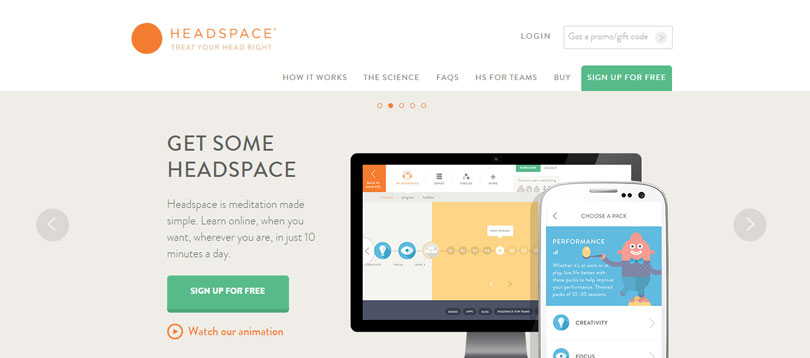
According to many people familiar with the practice of meditation, Headspace is the best app ever invented. The story behind the origin of Headspace is as intriguing as the business model itself.
A Tibetan monk for five years, Andy Puddicombe teamed with Rich Pierson, and the two of them designed Headspace- delivering guided meditation to the masses by leveraging technology. The app has more than 1 million subscribers and the basic one month subscription model costs 12$. You do the math…
So what is Headspace in terms of business?
A powerful passive income machine, if you ask me. How did they get there? Take notes.
The site
The first impression you are left with when visiting the homepage of Headspace, is the minimal and clean design. Colors, typography and graphics, all contribute to create this top-notch, captivating design that goes hand in hand with branding.
By using few slides on the homepage, above the fold without you having to scroll down even an inch, they are able to communicate their idea through.
Beautiful graphics and jaw dropping animations help in this regard rather much. Not an easy job at all, but outsourcing it I guess wouldn’t cost a fortune. We are talking about three or four animations, each a minute or two long. This is regarding the homepage; there are more animations as you start your practice.
The site serves to convert visitors into signing-up for the free sessions, and then these serve to convert them into long term subscribers. What are they selling? – A very structurally and methodically created meditation app.
Social proof and offline evangelism
Scrolling down the page, you will see testimonials and strong social proof. Now, largely, this is thanks to Andy who went out to promote Headspace and offered an intriguing story, as well as some teaching about the mind, how we perceive meditation, and what it actually is.
He spoke on TED, generating huge amount of attention, and later on was featured in many interviews, wrote many articles, and organized even more events.
Another thing I failed to mention in the guide above is the importance of evangelism and offline events in the online world. They all amount to a lot of press, lots of mentions, good both for PR and traffic, but SEO and branding as well. Rand Fishkin from MOZ always talks about the importance of creating life events.
Back to our case study, this generated some big headlines both in online as well as offline media. And having said that, it is very important to have someone representing the brand- a face behind the brand- not necessarily the CEO, but someone well versed in the niche, the idea, the vision of the company.
Remarkable features
The app itself is remarkably done. The UX, design, flow, methodical approach almost as if you are being led by a mentor… It can be used on both mobile and desktop and has some gamification methods implemented as well.
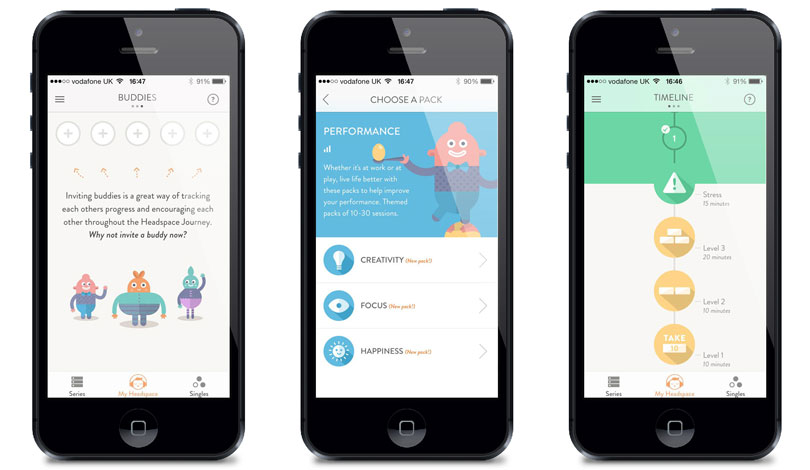
The guidance is top-notch, with audio files remarkably produced and honed to perfection. Recording them probably wasn’t as expensive as you and I both imagine them to be.
Additional material
Right on the homepage you will find a very well-made FAQ section, full with content that serves to educate and familiarize you with all the features of Headspace. Marketing done right if you ask me.
They also have a blog, which publishes relevant content daily, with the goal to educate and thus gain trust from new visitors, as well as serve subscribers and help them with their practice. Each page of the site is promoting the original design idea, and adds more captivating graphics. What I especially like here is the fact that almost every page except the pricing page has the same conversion goal- to make people sign up for free. Clever indeed. The pricing page, if you somehow decide not to buy subscription- which is rather hard considering that they’ve designed visitor flow in order to get you there only after being exposed to enough material- still settles for free sign-up as well.
The free material (10 days of headspace guided meditation) is perfectly leveraged, and serves as an automated sequence that further converts visitors into subscribers. Once seeing the benefits of meditation, introduced in such a way, people usually go for the requiring payment. And there, you have a member for life.
Excellent pricing page
This is one of those examples I encourage you to learn from. Not only is the pricing page incredibly made, but they added something else as well- for every one year membership that you buy, they will donate another one to someone in need. A very strong incentive when you consider everything else thus far.
Search optimized
The site itself is very “SEO friendly”, and on-page factors are paid attention to. The blog, along with the FAQ page provides for a lot of content, which is semantically relevant, and in demand from a user point of view- creating some much appreciated long tail keywords.
Andy wrote a series of articles for popular publications and magazines, and his events helped gather many mentions around the web. This all resulted with ranking very high for competitive and much targeted keywords, bringing tons of traffic to the site that later does a great job when it comes to converting visitors.
Check the site for yourself and try to resist the sign up form.
Other platforms they use are YouTube, SoundCloud, and Facebook and Twitter of course. They even promote coupon codes as to further encourage subscriptions. Being an app, it is featured on iTunes as well as Play store, where it ranks high due to excellent rankings and very positive reviews (this is how I’ve found them in the first place).
I hope that these case studies gave you enough material to analyze, or at least gave you a way to learn how to dissect online ventures and analyze them down to detail – figuring out even more creative solutions for your brand in the process.
Tools and Services
If I prologue the intro about this tool section, the same way I did with the intro of every section above, I’m likely to start receiving hate mail. Acknowledging this, I won’t spend a single second and start typing about them tools right away. North of 20, with the intention to update this list as soon as we discover something else that is noteworthy.
Transparent as always, there are some affiliate links within the list – meaning I will receive a small percentage of the sale, at no extra cost for you whatsoever. In fact, there are some discounts instead.
Most of these are free to use, and some of the software solutions charge a small fee per action (meaning, only when you are being paid by your customer). Those that offer paid packages, include free versions as well.
Here they are, by no chronological order whatsoever.
WordPress

WordPress is the easiest way to create your blog or website. It’s free, easy to use and there are thousands of plugins and themes available to transform your site into almost anything you can imagine. Oh, it’s also being used by over 60 millions people worldwide.
Digital Ocean
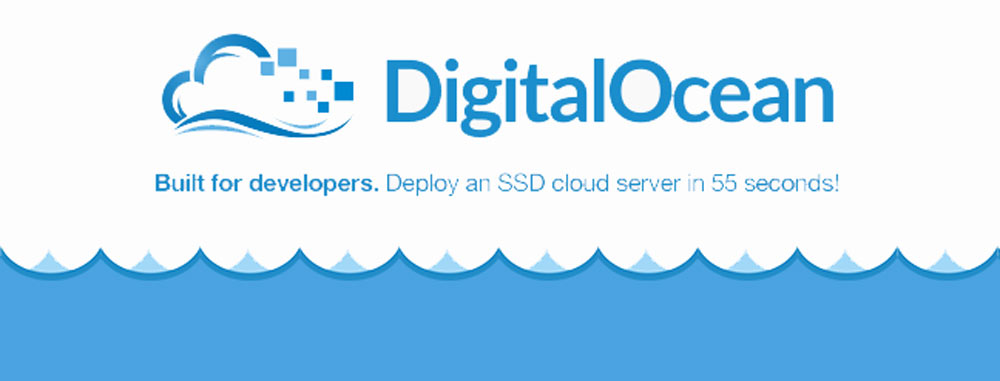
One of the simplest and cheapest cloud hosting solutions available. Its performance is superior compared to most shared hosts and it’s completely self managed, meaning you’ll have to configure everything about it. If you have the time and are not afraid of learning something new, this is the solution for you, if not, the managed shared hosting solution is just below.
Hostgator

Hostgator is one of the most popular and affordable hosting services on the net. It’s one of the world’s top 10 largest web hosting companies with more than 8,000,000 hosted domains.
Optimizely
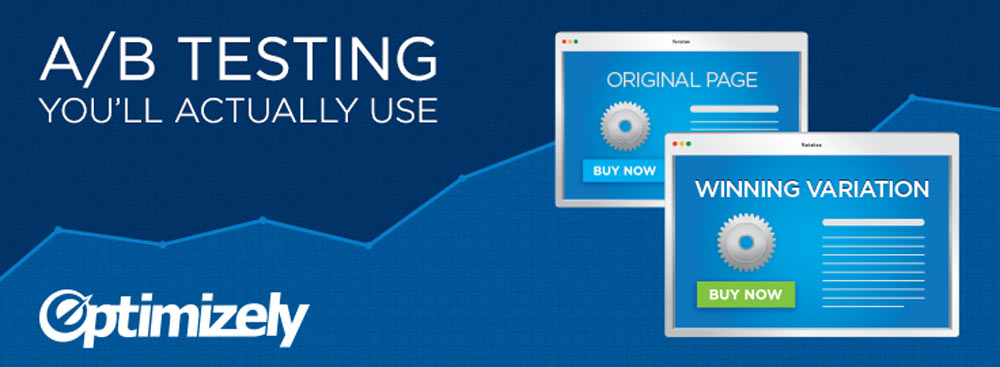
Optimizely is one the most popular A/B testing platform. A/B testing is a simple way to test changes to your page against the current design and determine which ones produce positive results. It is a method to validate that any new design or change to an element on your webpage is improving your conversion rate before you make that change to your site code.
Lead pages

Again, Lead Pages is a software solution I briefly mentioned in the section on conversion optimization. Allows you to create lead pages like nothing else on the market can. Collins has done an amazing job. Many industry leaders as well as big companies are using it – Pat Flynn does too.
OptinSkin

OptinSkin is customizable, cheap, buy-it-once-use-it-forever type of pricing. This is a very useful plugin for customizing your opt in box, and one that I advise for those on a budget. If you are having a blog, this is what you go with.
Pictochart
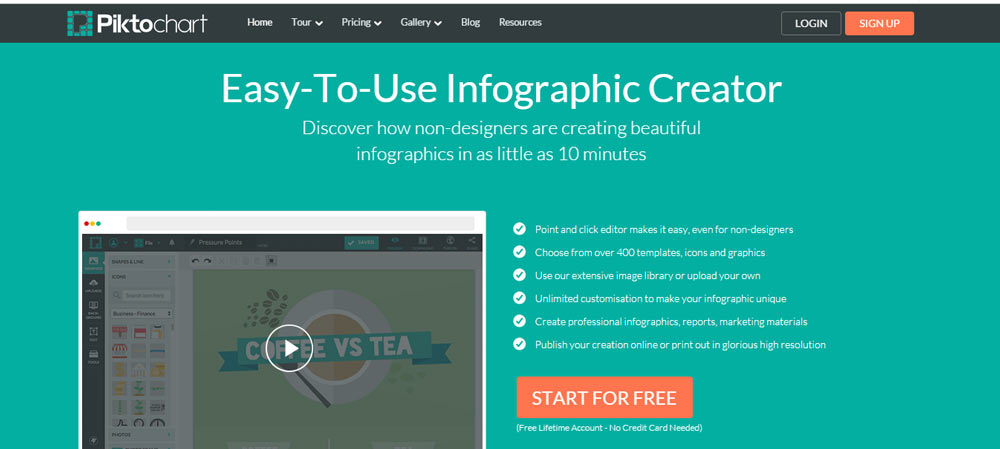
By far the best infographic creation tool on the market. The price is ridiculously low as well. You will be creating infographics with it within minutes, and the templates and graphic elements are so broad in number that you will never run out of material to present your content ideas.
Once again, the pricing is crazy – 29$ for a PRO account, and two months off if you pay annually. The option to upload your images, as well as over 4000 icons to use… The best way to go about creating an infographic if you don’t have the skills or work on a budget.
Sumome
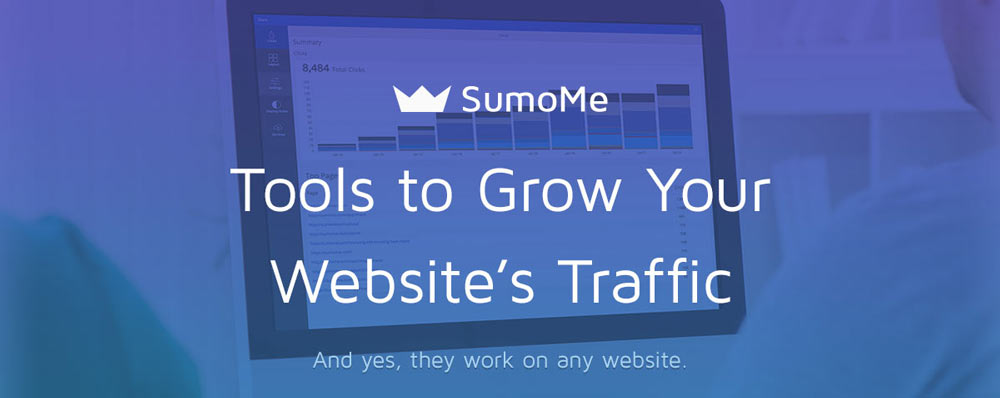
We mentioned it once, now to say a couple of words more.
Sumome is by far the best tool on the market that allows you to analyze your visitor’s behavior, and help you in your conversion goals. It is very useful when it comes to gathering emails, with 20% daily increase of your subscription rate.
Also, the easiest setup for sharing buttons, and a smart mode which takes care of the whole process, optimizing it as user data dictates.
The starter plan is great to begin with. But the free version is there as well.
We managed to increase our emails subscribers by more than 50%.
BuzzSumo
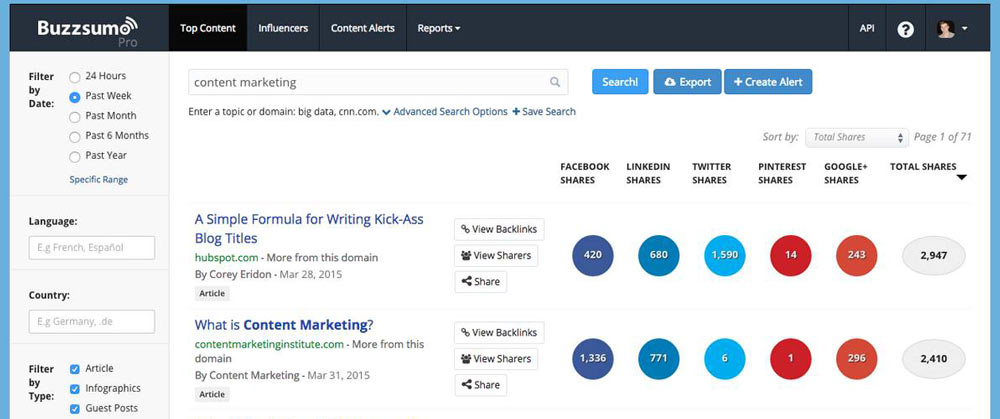
Another tool by Noah Kagan, and this one is a must for content creators.
What BuzzSumo allows you to do, is search an industry and find the most shared content, the influencers, their work, the sites that publish content that tends to go viral… And much more.
You can see what content is performing well for an industry or a competitor, and filter the results by type of content (infographic, articles, video, giveaways…), and country, language and date.
This is a tool that I cannot recommend enough.
Moz Pro
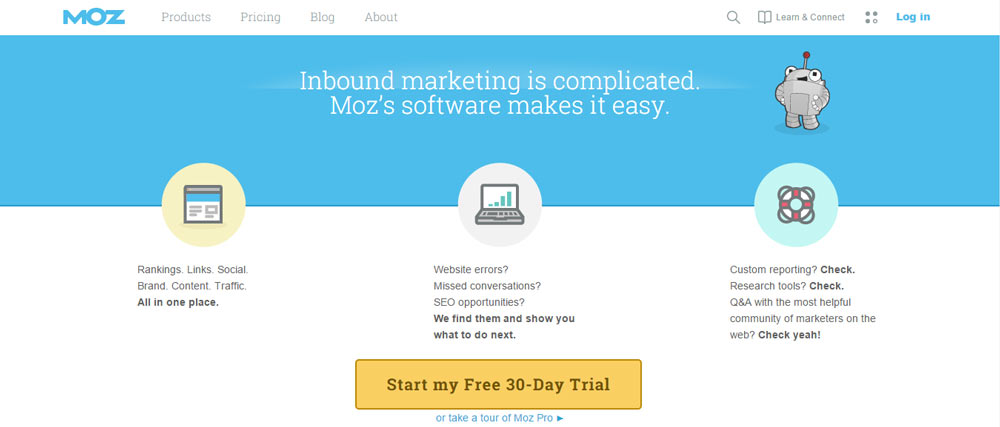
Moz offers a 30 day trial of a suite of 12+ tools, including Moz Analytics, Open Site Explorer, Followerwonk, etc… to track and improve your SEO, social, branding, link building, and content marketing efforts. The Moz Pro subscription saves you time by giving you an all-in-one set of SEO research and analytics tools that help increase your search engine visibility and keep you ahead of your competitors.
Ahrefs
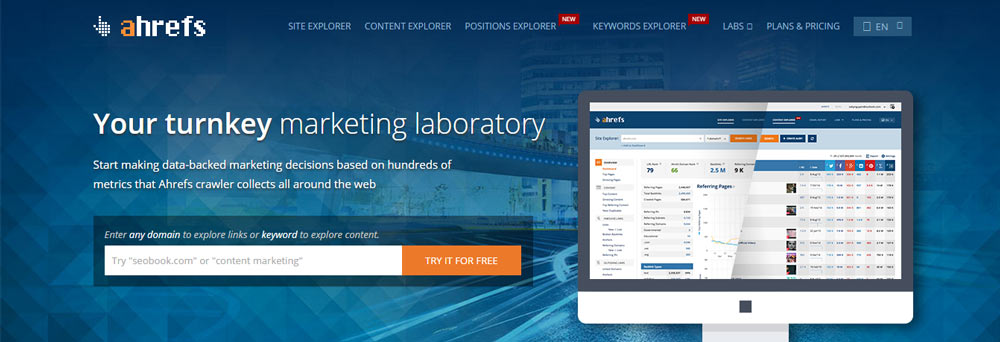
If you are interested in SEO, and need to evaluate the link profile of a site, Ahrefs is one of the best tools currently available. It will also give you info such as who is linking to a given URL, along with scores, anchor text distribution, historic data, and much, much more…
MaxBounty

One of the highest paying affiliate network out there. Max Bounty has quickly gained traction among affiliate marketers, mostly because they work hard to bring you the best offers in any industry, along with the best rates.
Campaigns that convert well, and an ever growing network of products and services to promote.
What they also do better than most affiliate networks, is caring about their affiliates. An account manager is assigned to follow your progress, inform you about new available deals, and work with you in order to improve your business.
You also get to participate in competitions that have a way of ending up in Hawaii Vegas, Peru… A cool startup and one that cares a lot.
They also pay weekly via numerous payment methods.
Payoneer

The one card to rule them all.
This is by far the best method of money transfer. Payoneer, unlike PayPal, works in all countries around the world (very few exceptions). They charge you ridiculously low fees for money transfer, and give you a MasterCard to carry around in your wallet.
Wherever you go, whichever ATM you decide to use, you can withdraw money for almost no fees at all. You can also use this debit card for payment in, say, retail stores.
Stripe
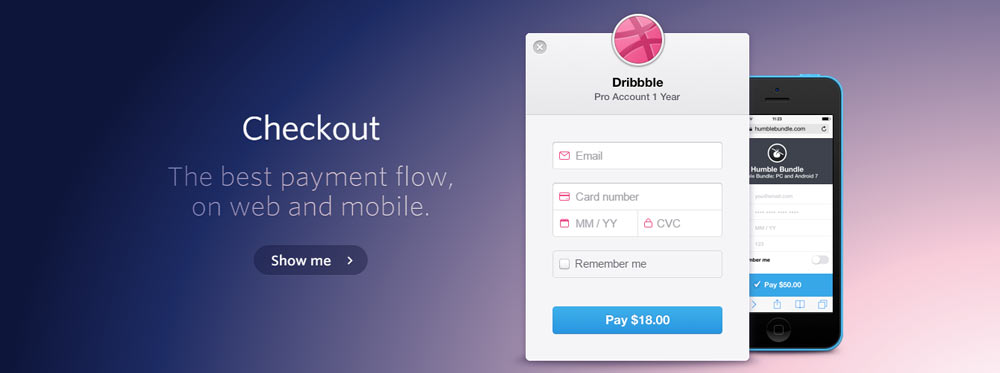
If you are looking for software that handles money processing, look no further for you’ve discovered the best there is.
Stripe charge ridiculously low fees for every transaction, and you never get to see a bill – the money are paid while the transaction is being processed- meaning, they take a small insignificant percent of the sum, and the rest proceeds to your account. Later, you can choose among many ways of receiving your money. Payoneer included.
Shopify

The best software for creating online stores. It is easy to use, and takes the stress away from building and managing an online store.
WayBack Machine

One of the coolest tools of all. Wayback machine allows you to see a screenshot of a given site, at any date in the past. The ways in which you can use such a tool are numerous at best.
- You can, as I did with Wait But Why, gain insight into the number of e-mail subscribers or social proof of a given site in the past. This way you can better evaluate competitors, or even the entire market.
- You can see design ideas changing, hence knowing what works and what doesn’t (if people were changing the design, and then changing again some features, you can learn what works without ever doing A/B testing yourself. Just imagine what the use of this tool can give you).
It is free, so allow me to shout out loud – USE THIS TOOL AND PLAY WITH IT. A LOT.
Social Bakers

Another very useful tool to play with. Social Bakers is by far one of the best tools for analyzing social channels, and improving your own campaigns. It offers many features, one of which is giving insight into what content performs the best on a given Facebook page.
The scope of information it gives is so broad, that I can go ahead and write a whole article about it.
Happy Apps
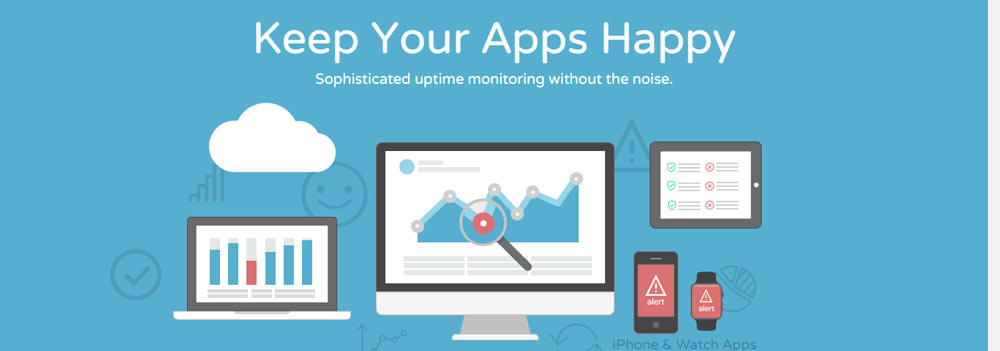
Monitoring a number of apps was never easier. Uptime, usage data, everything that you need in order to rest assured that your app is performing as intended.
Similar Web
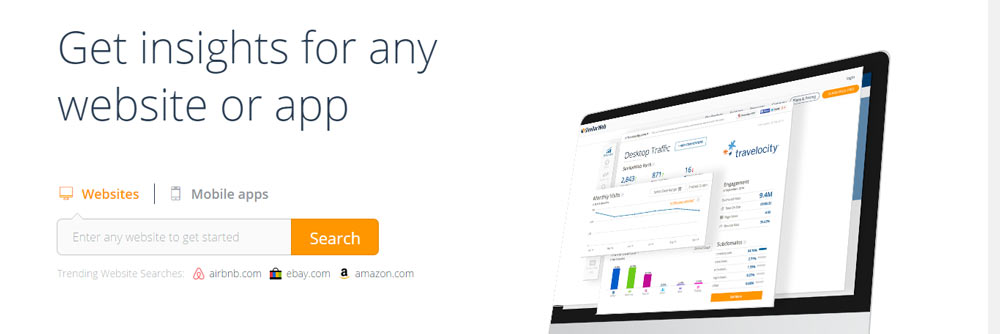
Forget about Alexa – it’s a relic of the past – Similar Web is the tool you should use in order to analyze a website to the bone. Traffic estimates, types of traffic, referring sites, countries from where the traffic comes, top referral sites, social referrals, search traffic, keywords used… This is the tool to use when analyzing websites.
Impersonal.me

This tool helps a lot when analyzing search results over different locations. Say you want to know who is ranking for a given term in Russia and who in US. This tool allows you to do exactly that. You can choose the language, location and do your non-personalized search. Guess what – it is free.
Moz Bar plugin extension
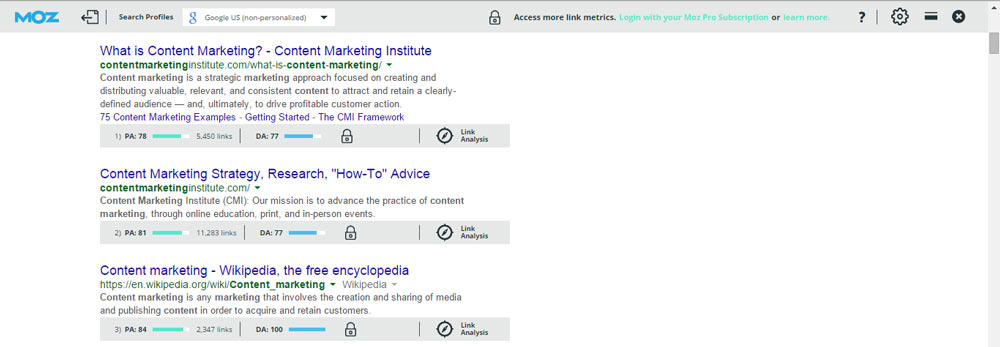
What the Moz bar allows you do to is access important SEO metrics at a glance while you surf the net. It is by far the easiest way of determining how a site fares within the SERPS.
It has a ton of other features as well, and even deeper analysis available for Moz Pro users.
Follower Wonk
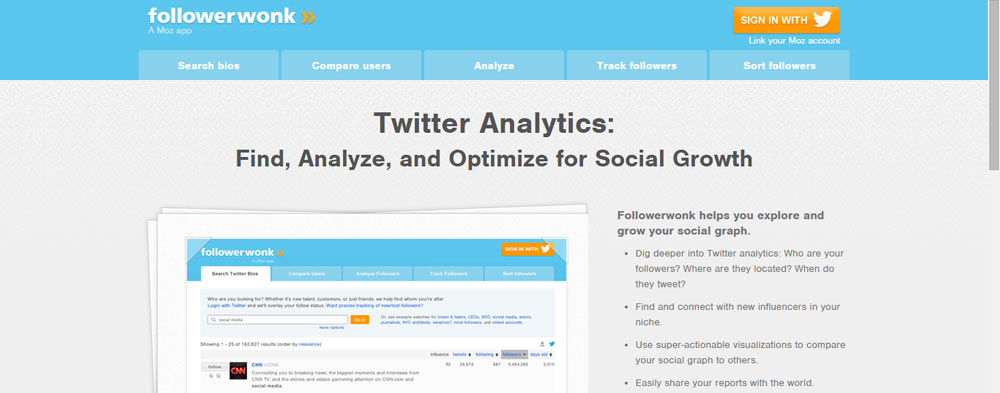
A Twitter analytics tool which allows you to find influencers and people to follow; analyze your followers breaking them down by many demographic groups; and optimize your activities in order to gain more followers and hone your social graph.
Bitly
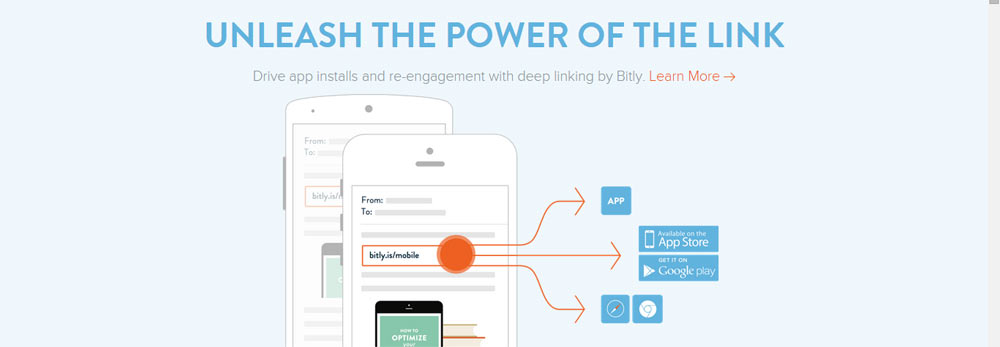
Shorten your links, brand them, analyze the traffic that goes through them, drive app installs and engage your audience with deep linking. This is the best tool you will find on the market.
RSS feed reader by feeder.co

I use this one, but you can go with others as well. The point is to get yourself used to consuming content, especially from sites within your industry. The RSS feed reader is the best option to stay in touch with what your competitors are producing, as well as follow your favorite sites (refining your content intake, developing a better eye for content ideas).
Headspace
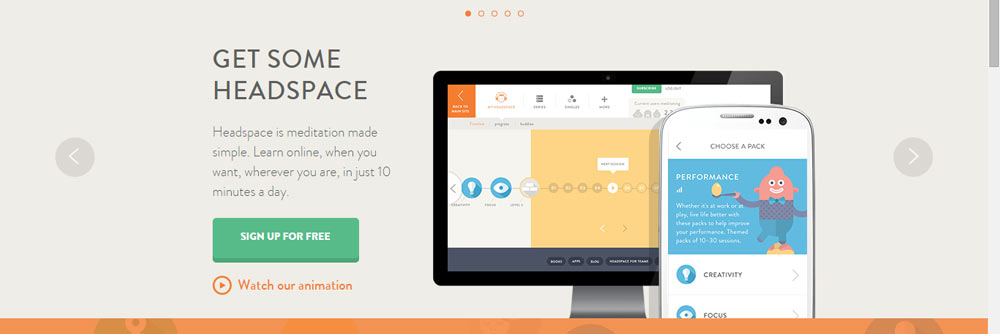
Said it once, about to say it again – this line of work is very unpredictable, offering circumstances that are rarely permanent and thus likely to cause a lot of stress and mixed feelings… Headspace, at least for me, is as great of an anchor as they come.
So, there you go, a lot of tools and software solutions for you to utilize. Some of them are free, but most include a free version or a trial period. With a number of these tools on your belt, there is exponential growth guaranteed, and many new horizons opened up ahead.
Give the free guide above an extra read from time to time, tell your friends about it by sharing on social channels… (I’ve just discovered that it is against the law to go down the street and yell about it, so for now, social channels it is…)
All the best, and enjoy yourself creating one helluva business.

 Before I start chaining myself to trees and saving the dart frogs, though, I should take my own advice: Do not become a cause snob. How can you help starving children in Africa when there are starving children in Los Angeles? How can you save the whales when homeless people are freezing to death? How does doing volunteer research on coral destruction help those people who need help now?
Before I start chaining myself to trees and saving the dart frogs, though, I should take my own advice: Do not become a cause snob. How can you help starving children in Africa when there are starving children in Los Angeles? How can you save the whales when homeless people are freezing to death? How does doing volunteer research on coral destruction help those people who need help now?